Fish and Shellfish
CHAPTER 5
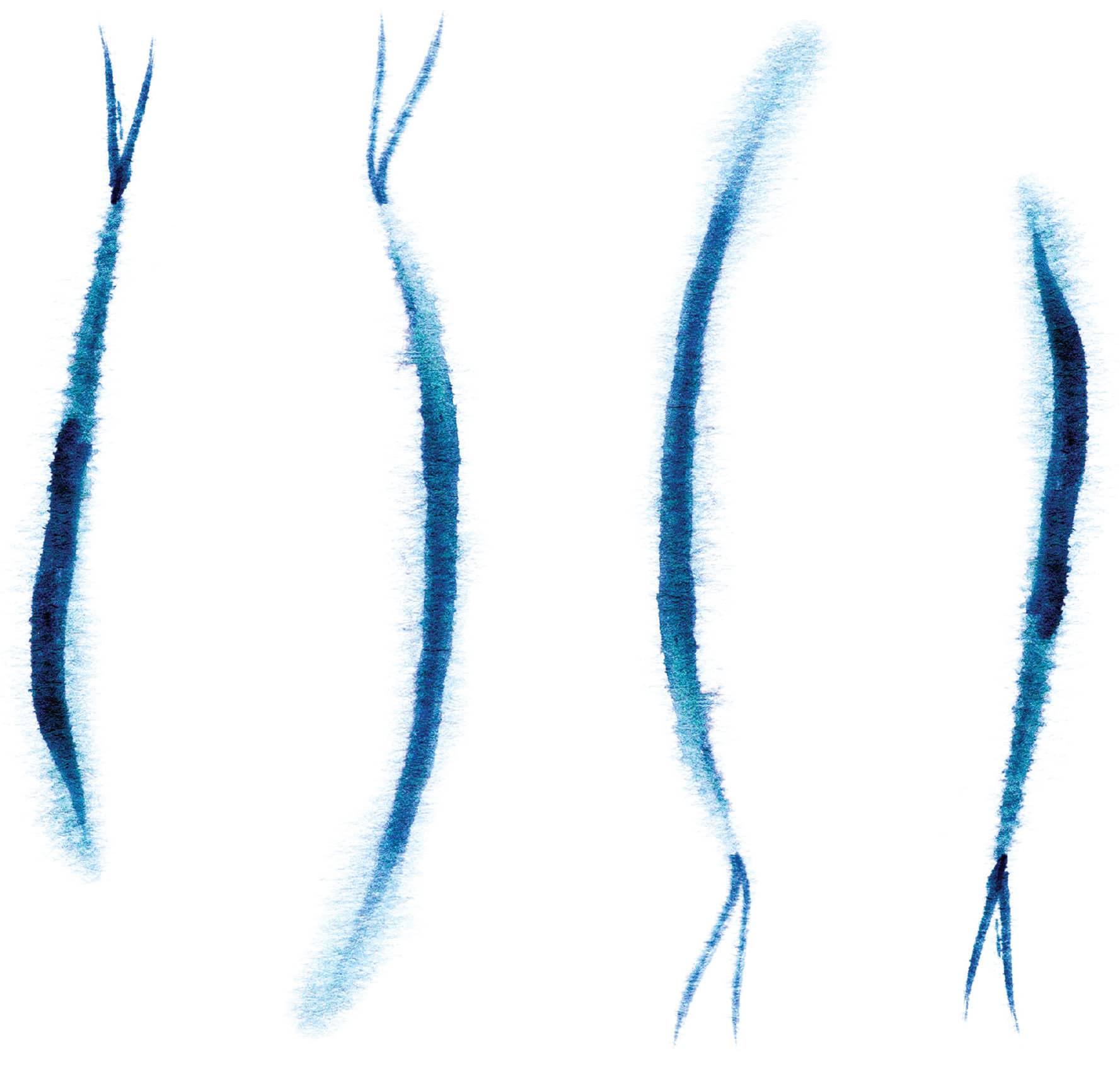

FOR 4 AS A MAIN COURSE OR 6 AS A STARTER
◁ Salmon sashimi, cucumber, tomato, ginger, almond and yogurt
SLIGHTLY CHILLED
Rather like a generous sashimi assembly, this refreshing dish works a treat after a bowl of miso soup or tomato gazpacho. It can be made from most fish, but the oiliness of salmon works especially well with the cucumber. Other fish worth trying are halibut, bream (larger ones), tuna and cod, as well as scallops.
INGREDIENTS
1 cucumber, peeled, halved lengthways and deseeded
16 cherry tomatoes, halved
3 tbsp lemon juice
2 tsp finely chopped or grated ginger
1 tsp wasabi paste (or use creamed horseradish or mustard paste)
4 tbsp Greek-style plain yogurt
4 tbsp soy sauce
4 tbsp mirin (or use 2 tbsp runny honey dissolved in 2 tbsp warm water)
700g (1lb. 9oz.) very fresh salmon loin (the thickest part), skin and bones removed
1 small handful salad leaves (I used wild rocket/arugula)
2 tsp extra virgin olive oil
20g (3/4oz./1/4 cup) flaked almonds, toasted
cress or micro-greens, for garnish (I used baby red-veined sorrel)
[ METHOD ]
Slice the cucumber 5mm (1/4in.) thick crossways. Mix with the tomato halves, lemon juice, three quarters of the ginger and 1/2 teaspoon of salt. Leave to macerate for 30 minutes in the fridge. Drain before using.
Mix the wasabi into the yogurt and place in the fridge.
Mix the soy and mirin with the remaining ginger.
Slice the salmon 5mm (1/4in.) thick and, when you’re almost ready to serve, gently toss it with the soy mixture. Leave to marinate for 5 minutes, then drain in a colander, being careful not to crush the flesh.
To serve, lay the salad leaves and salmon on chilled plates. Scatter on the cucumber and tomatoes. Dollop on the yogurt, drizzle with the olive oil and sprinkle on the almonds, cress and some flaky salt.
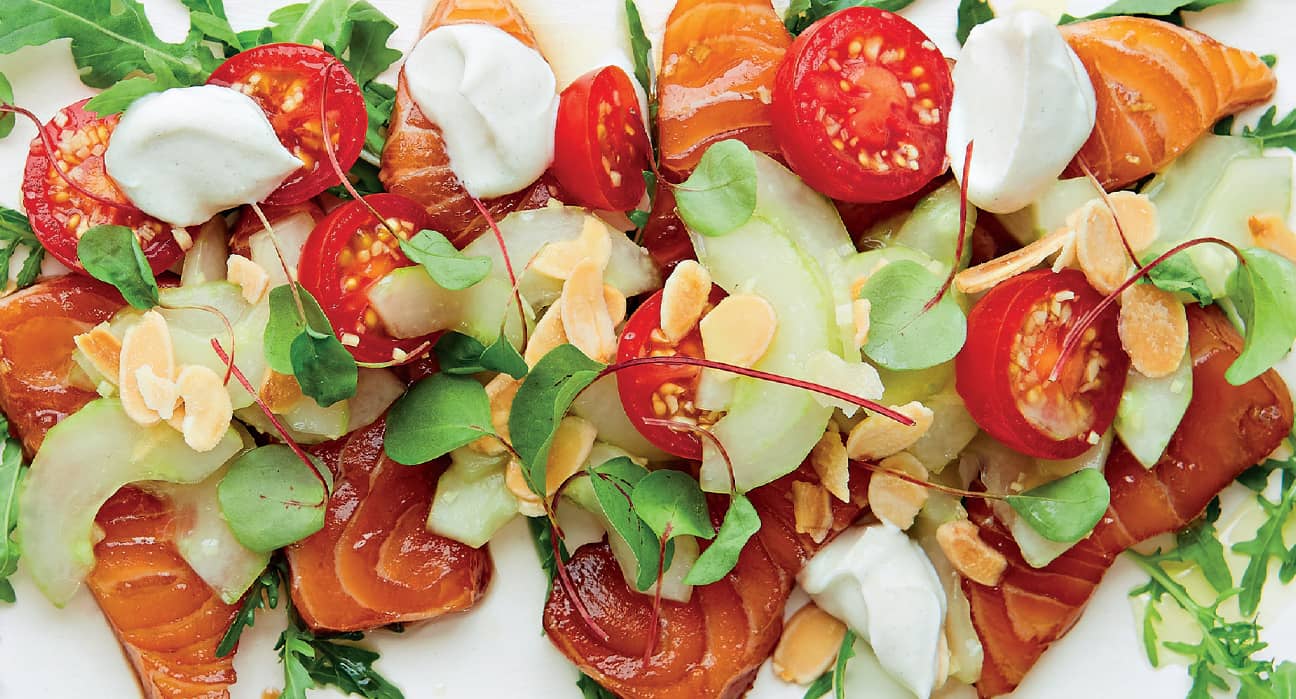
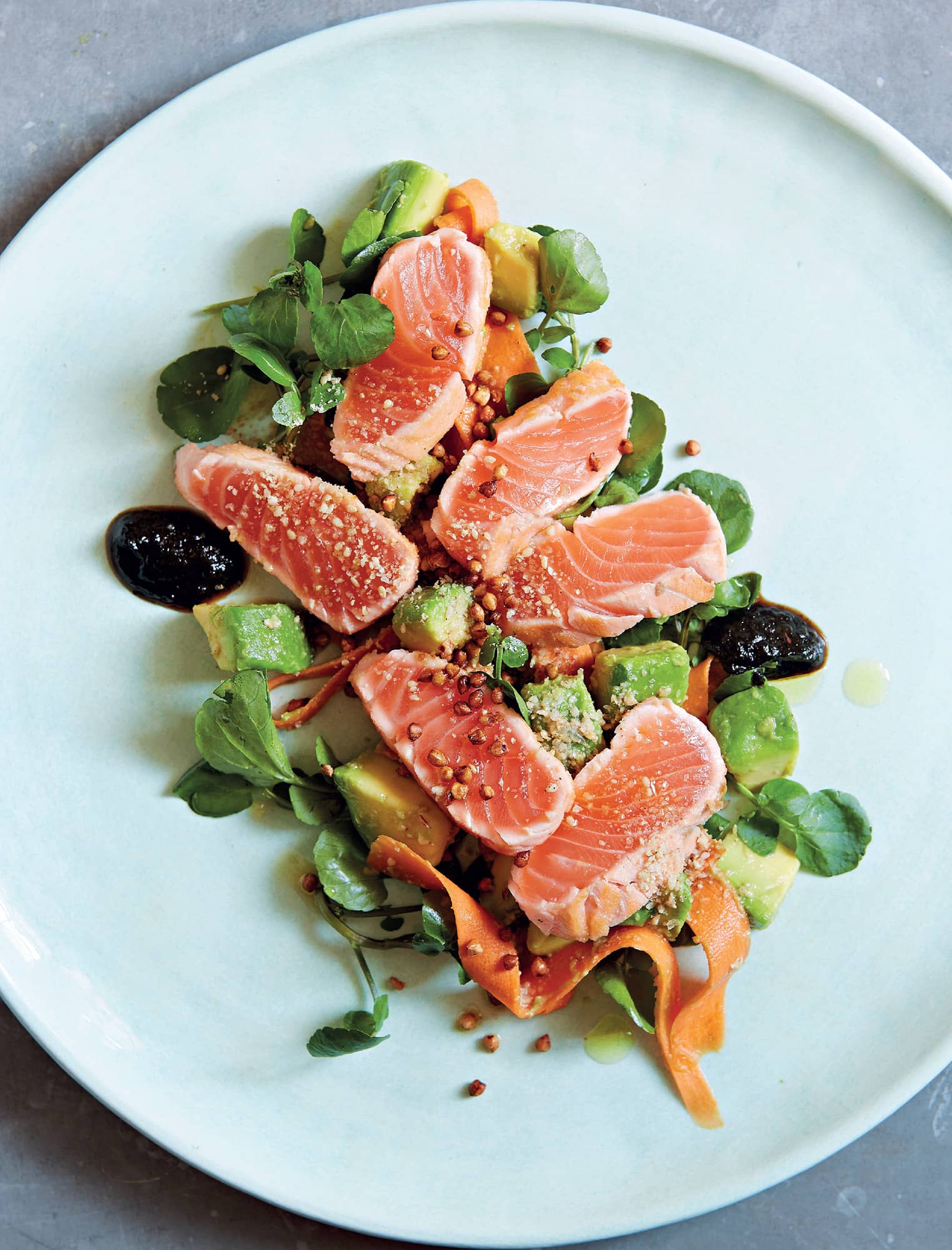
FOR 4 AS A MAIN COURSE
◁ Seared salmon, nori sauce, crispy buckwheat, gomasio and avocado
AT ROOM TEMPERATURE
Everything except the searing of the fish can be done at least a few days ahead, so with good planning you’ll be able to pull off what would seem to be a restaurant-quality dish. To really make this look fabulous you’ll need to use the loin of the salmon, which is the thickest part of the salmon fillet. Make sure all skin and bones, and the blood line, are removed before you start. This is also delicious made with tuna. Goma is the Japanese word for sesame, and shio is the word for salt (or tide, as in a tidal sea), and gomasio (sometimes spelled gomashio) is a Japanese seasoning that I always have to hand: by pounding toasted sesame seeds with flaky sea salt you get a most delicious savoury seasoning that has much less salt, which has got to be good for you.
INGREDIENTS
600g (1lb. 5oz.) chilled salmon loin (see recipe introduction), cut into four 150g (5 1/2oz.) portions
light cooking oil
2 avocados
2 tbsp lime (or lemon) juice
1/4 tsp finely grated lime (or lemon) zest
2 carrots, peeled, topped and tailed, then peeled into ribbons
100g (3 1/2oz.) picked and washed watercress tips
4 tbsp nori sauce
4 tbsp crispy buckwheat
FOR THE GOMASIO
1 tbsp toasted white sesame seeds
1/2 tsp flaky salt
[ METHOD ]
Have a large bowl of iced water ready. Take the salmon from the fridge, pat dry with absorbent kitchen paper, then brush each piece with 1/2 teaspoon of oil and lightly sprinkle with salt.
Heat a heavy-based, ideally non-stick, frying pan (skillet). When it’s smoking, place a portion of salmon in and cook for 15 seconds, then carefully, but quickly, roll it over to sear and colour all of the outer parts. Remove the salmon and plunge it into the iced water to prevent it cooking any further. Cook the remaining portions in the same way.
Once all four pieces have been submerged for 4 minutes, carefully remove from the water and pat dry on a tea (dish) towel. Place, covered, in the fridge for up to 6 hours before assembling.
Make the gomasio by roughly pounding the sesame seeds using a mortar and pestle, then pounding in the salt briefly, keeping it a little chunky.
Just before serving, remove the flesh from the avocados and cut into chunks. Toss with the lime juice and zest. Add the carrot and gently toss together with a quarter of the gomasio.
To serve, divide the salad among your plates and scatter with the watercress. Slice the salmon 5mm (1/4in.) thick and lay this on top. Spoon the nori sauce on, then sprinkle with the remaining gomasio and the crispy buckwheat.

◁ Nori sauce
This makes much more than you need, but it is tricky to make a much smaller batch and it will keep in the fridge for 3 weeks if tightly covered.
INGREDIENTS
30g (1oz.) nori (about 10 sushi-sized sheets)
100ml (scant 1/2 cup) mirin
100ml (scant 1/2 cup) sake
75ml (5 tbsp) tamari (wheat-free soy sauce)
3 tbsp red wine vinegar
[ METHOD ]
Carefully toast half of the nori over an open flame, in a frying pan (skillet) or under a grill (broiler). Because it’s almost like paper it can catch fire, so keep an eye on it. You want it to change colour from almost black to green. Tear (or cut with scissors) both the toasted and untoasted nori sheets into very small pieces.
Put all the liquids in a pan and bring to the boil, then reduce to a rolling simmer and gradually stir in the nori until you have a thick pasty-looking mixture. Cook for 1 minute, stirring constantly.
Blitz with a stick blender to a paste, then chill and store in the fridge.
Crispy buckwheat
You can make this up to a week in advance and store it in an airtight container. The quantities given here will make more crispy buckwheat than you need for this dish, but once you’ve tasted how good it is, you’ll be sprinkling it onto everything from a simple green salad to a beef stew. Whole buckwheat should be easy to find at a health food store but as an alternative you could use toasted nuts or pumpkin seeds to give crunch to the dish.
INGREDIENTS
50g (1 3/4oz./generous 1/4 cup) whole buckwheat grains, rinsed and drained
about 300ml (1 1/4 cups) sunflower or other plain oil
[ METHOD ]
Pour 500ml (2 cups) of hot (but not boiling) water over the buckwheat in a bowl and leave for 6 hours or overnight.
Drain into a sieve, then pat dry on a kitchen cloth.
Pour enough oil into a medium pan or frying pan (skillet), about 24cm (10in.) diameter, to give you 2cm (3/4in.) depth. Place over a medium heat and when the oil reaches 150°C (300°F), add the drained buckwheat.
Fry gently, stirring frequently, until the grains begin to stop sizzling and have turned golden brown. Drain in a heatproof sieve or small-holed colander, then lay it on baking paper, sprinkle with flaky salt and leave to cool. Once the oil has cooled you can strain and reuse it.
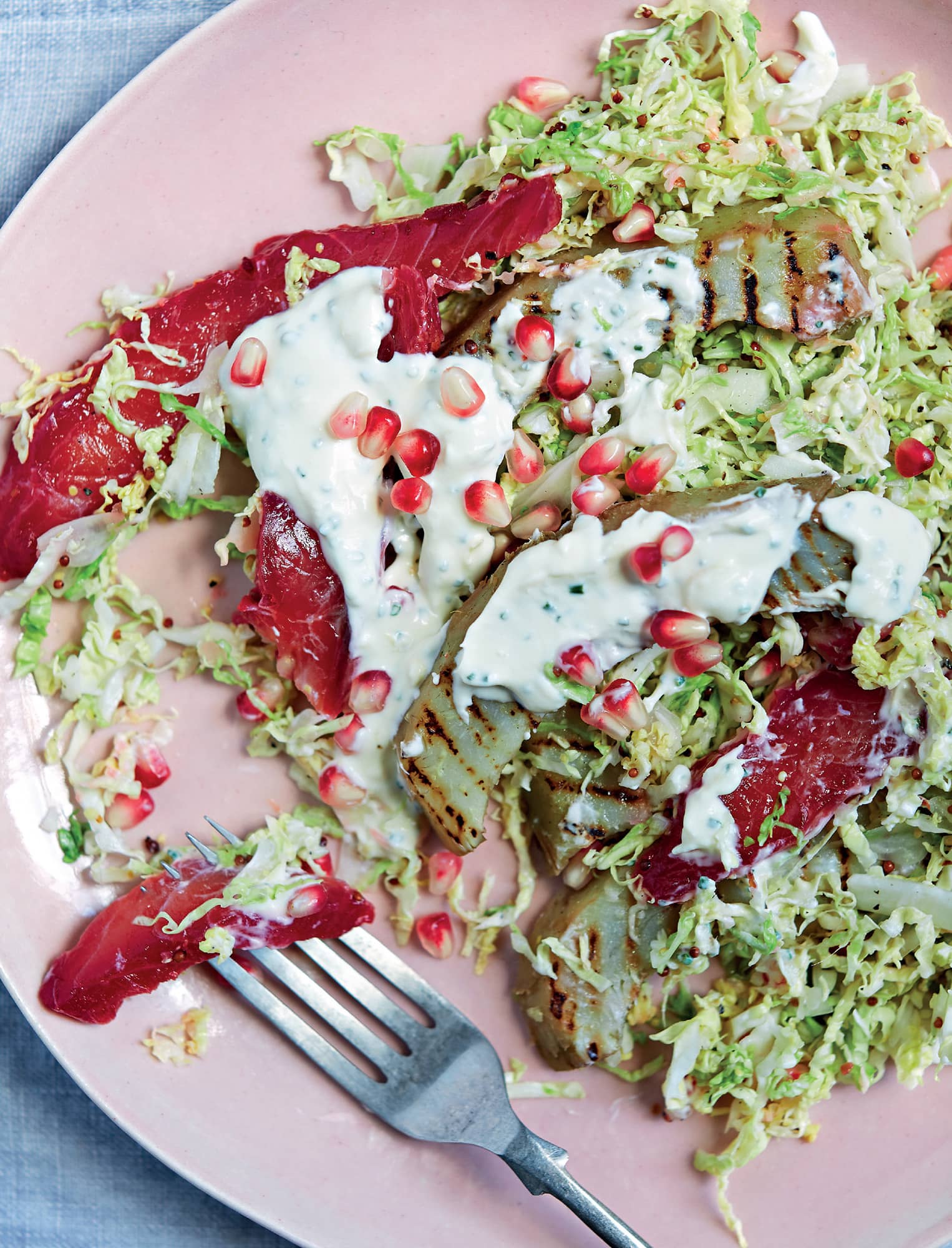
FOR 8 AS A STARTER
◁ Beetroot-cured salmon, grilled artichokes, shredded cabbage, crème fraîche and pomegranate
AT ROOM TEMPERATURE
I was in my local London Fields fishmongers when several fabulous wild Scottish salmon arrived. They weren’t big, like farmed salmon, but they were really firm and I knew I wanted a whole fillet for this. If your salmon is larger and fatter, then it may need up to 72 hours curing. This style of curing with salt, sugar and lemon juice can also be applied to other fish fillets such as halibut, tuna or cod, as well as beef or farmed venison fillet. Ideally, cure it for 2 days before you need it so it has time to firm up once the marinade is wiped off. If you don’t have time to cure the salmon, then use sliced cold-smoked salmon instead.
INGREDIENTS
2 tsp coriander seeds
1/2 tsp chilli flakes (or use 1/4 fresh chilli or more to taste)
1 tbsp finely grated lemon zest
125g (4 1/2oz./2/3 cup) golden or pale unrefined sugar
125g (4 1/2oz./2/3 cup) coarse sea salt
4 tbsp grated ginger
1 red beetroot (beet) (raw or cooked), peeled and coarsely grated (shredded)
500g (1lb. 2oz.) salmon fillet, skin, bones and bloodline removed
3 tbsp lemon juice
2 juicy lemons
2 bay leaves
10cm (4in.) fresh thyme sprig
5cm (2in.) rosemary sprig
4 globe artichokes
2 tbsp extra virgin olive oil
300g (10 1/2oz.) young Savoy cabbage, outer leaves and core discarded
2 tbsp grain mustard
1 tbsp finely snipped chives
200ml (3/4 cup + 2 tsp) crème fraîche (thick sour cream)
3 tbsp pomegranate seeds
[ METHOD ]
Roughly pound the coriander seeds with the chilli flakes and half the lemon zest using a mortar and pestle. Mix in the sugar, salt and two thirds of the ginger. Wearing gloves, mix in the beetroot (beet). Tip a quarter of this curing mixture on the bottom of a non-reactive dish just large enough to hold the salmon and lay the salmon on top. Pile the rest of the cure on top, rubbing it evenly all over, and press down firmly. Drizzle on 1 tablespoon of the lemon juice. Press cling film (plastic wrap) down on the fish and seal tightly. Place in the fridge for 48 hours.
Wearing gloves, remove the salmon from the curing mix and wipe off any excess mixture. Pat the salmon with absorbent kitchen paper, then wrap it tightly in cling film (plastic wrap) and leave in the fridge for up to 4 days.
Bring a large saucepan of salted water to the boil. Slice one of the lemons 5mm (1/4in.) thick and add to the pan along with the bay leaves, thyme and rosemary. Reduce the heat to a simmer and put a lid on.
Holding an artichoke by its stalk, pull the thick leaves from the base of the head until they begin to visibly thin and soften. Lay it horizontally on a chopping board and, using a sharp serrated knife, cut off and discard the top half. (Be careful as the head can slide around a little and they can be a little tough.) Cut the stalk off, near the base of the head, then trim off any rough edges using a small sharp knife. Using a teaspoon or a melon-baller, dig into the cavity of the artichoke to remove the hairy fibres. Cut the remaining lemon in half and rub each cleaned choke with them to prevent discolouring. Once all the artichokes are done, add to the pan of simmering water, making sure they’re covered, and bring back to a gentle boil. Cook until you can insert a thin sharp knife through the thickest part (about 15 minutes depending on the size of the artichokes). Remove with a slotted spoon to a colander to drain and cool. Discard the poaching liquid.
Heat up a frying pan (skillet) or griddle pan. Slice the artichokes vertically 1cm (1/2in.) thick and toss with 1 tablespoon of the olive oil, salt and pepper. Grill until marked and coloured and leave to cool.
Shred the cabbage as thinly as you can. Mix the remaining ginger with the remaining 2 tablespoons of lemon juice, the mustard and a little salt and pepper. Mix this into the cabbage and leave in the fridge for at least an hour.
In a small bowl, mix the remaining lemon zest and the chives into the crème fraîche (thick sour cream).
To serve, unwrap the salmon and slice into 5mm (1/4in.) thick pieces. Lay the cabbage on your plates, then the artichokes on top. Top with the salmon. Spoon on the crème fraîche (thick sour cream), drizzle with the remaining olive oil and scatter with the pomegranate seeds.
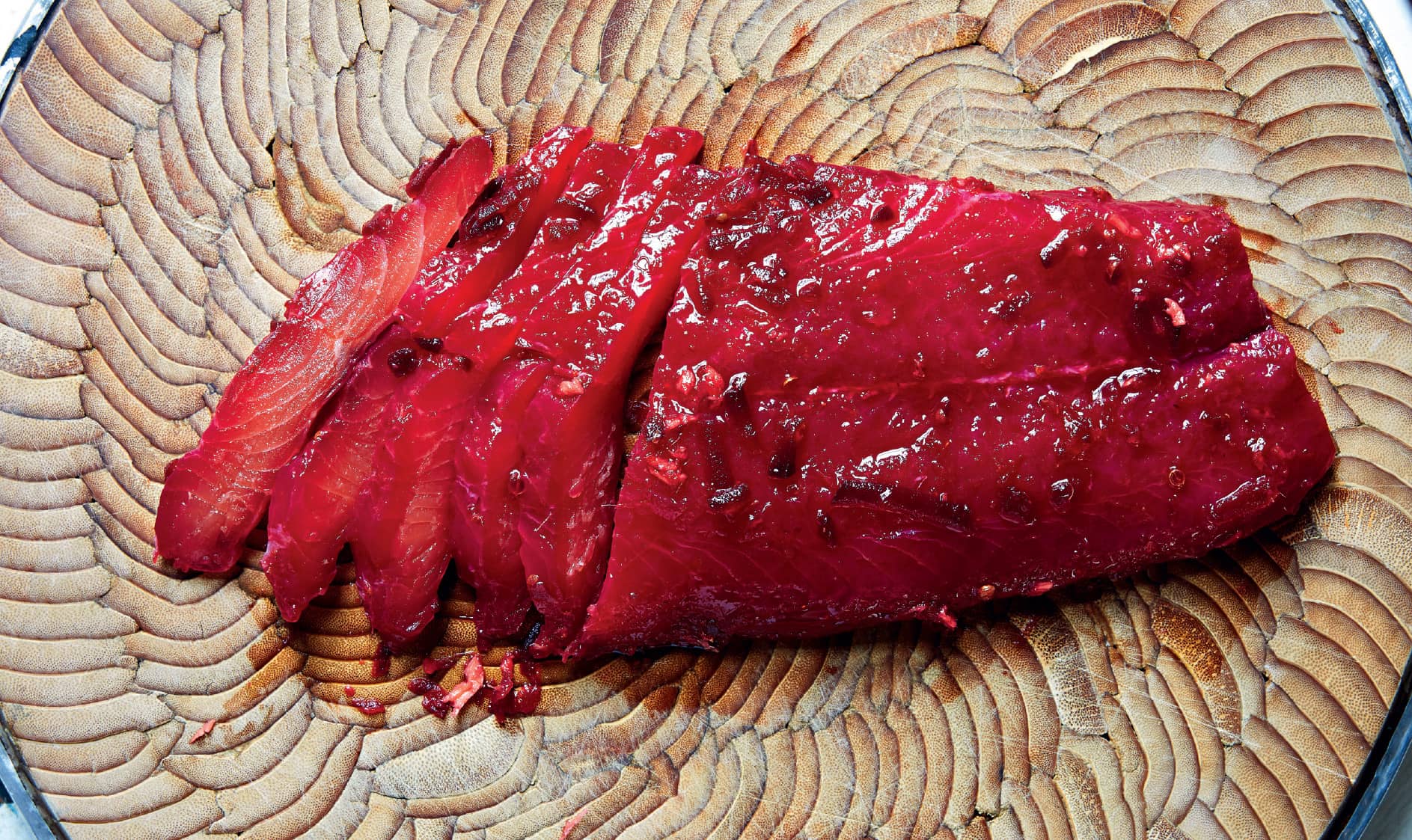
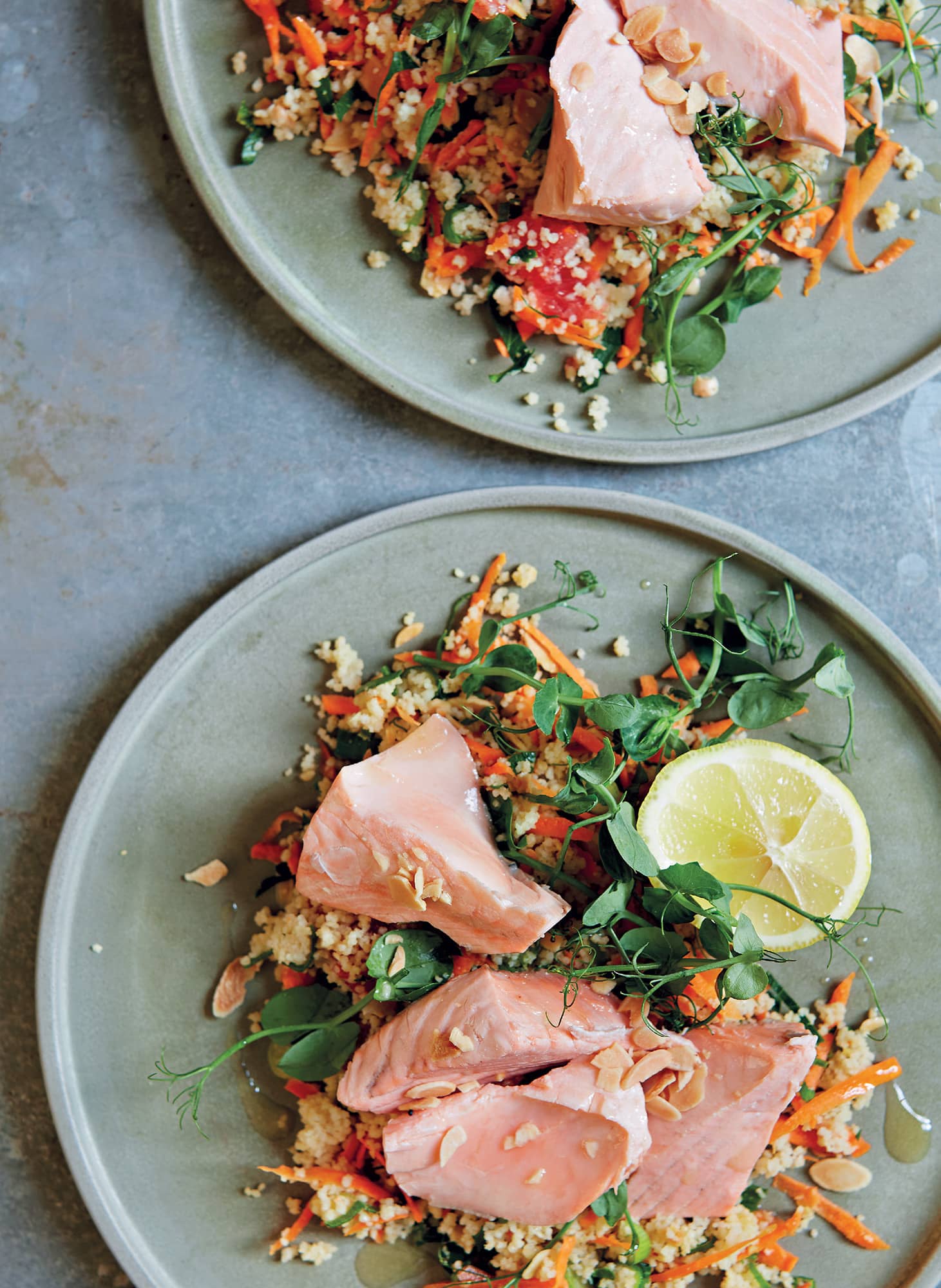
FOR 2 AS A MAIN COURSE
◁ Poached salmon, almond and grapefruit couscous
WARM OR AT ROOM TEMPERATURE
This is a healthy and light meal and you can serve the salmon straight from the poaching liquor or at room temperature. Poach the salmon in a saucepan wide and deep enough to hold the pieces in one layer. Ideally, it should be at least 8cm (3in.) deep. The couscous can also be served with a variety of other fish or meats, or topped with grilled (broiled) vegetables, salad leaves and toasted mixed seeds and nuts. Never use boiling water to soak your couscous – it makes it clump together.
INGREDIENTS
100g (3 1/2oz./generous 1/2 cup) couscous
1 carrot, peeled and coarsely grated (shredded)
1 tbsp extra virgin olive oil
2 spring onions (scallions)
1 small handful flat-leaf (Italian) parsley on the stalk
1 grapefruit
2 salmon fillets (150–175g/ 5 1/2–6oz. each), bones removed but skin left on
3 tbsp flaked almonds, lightly toasted and roughly chopped
1 small handful salad leaves (I used pea shoots)
1 lemon, halved
[ METHOD ]
Mix the couscous with 100ml (scant 1/2 cup) of tepid water and 1/4 teaspoon of salt and leave for 5 minutes. Mix in the grated (shredded) carrot and olive oil and leave for an additional 5 minutes. Trim both ends from the spring onions (scallions). Thinly slice the green parts and mix into the couscous. Pick the parsley leaves from their stalks (keep the stalks), coarsely shred and add to the couscous.
Put the parsley stalks and spring onion (scallion) white ends in a pan. Add water to a depth of 4cm (1 1/2in.) and 1 teaspoon of salt, bring to the boil then reduce to a rapid simmer. Peel three strips of rind from the grapefruit, avoiding any white pith, and add to this poaching stock as it heats up.
Gently lower the salmon pieces into the simmering stock, skin side facing down, and bring back to the boil.
Turn off the heat, put a lid on the pan and leave for 8–10 minutes, by which time it will be cooked (if the salmon is thin, and submerged, then leave it for no more than 4–5 minutes).
Meanwhile, segment the grapefruit (see Spelt, grilled radicchio, citrus, cashews, avocado and black radish). Cut each segment into three or four pieces and mix into the couscous along with the almonds and any juice you can squeeze from the grapefruit core.
To serve, divide the couscous among your plates and sit the pea shoots on top. Remove the salmon carefully from the poaching liquid and lay on a plate, skin side facing up. Peel off the skin and scrape away any dark-coloured flesh (the blood line) under the skin using a teaspoon. Break the salmon into flakes and sit it on top of the couscous. Tuck in a lemon half.
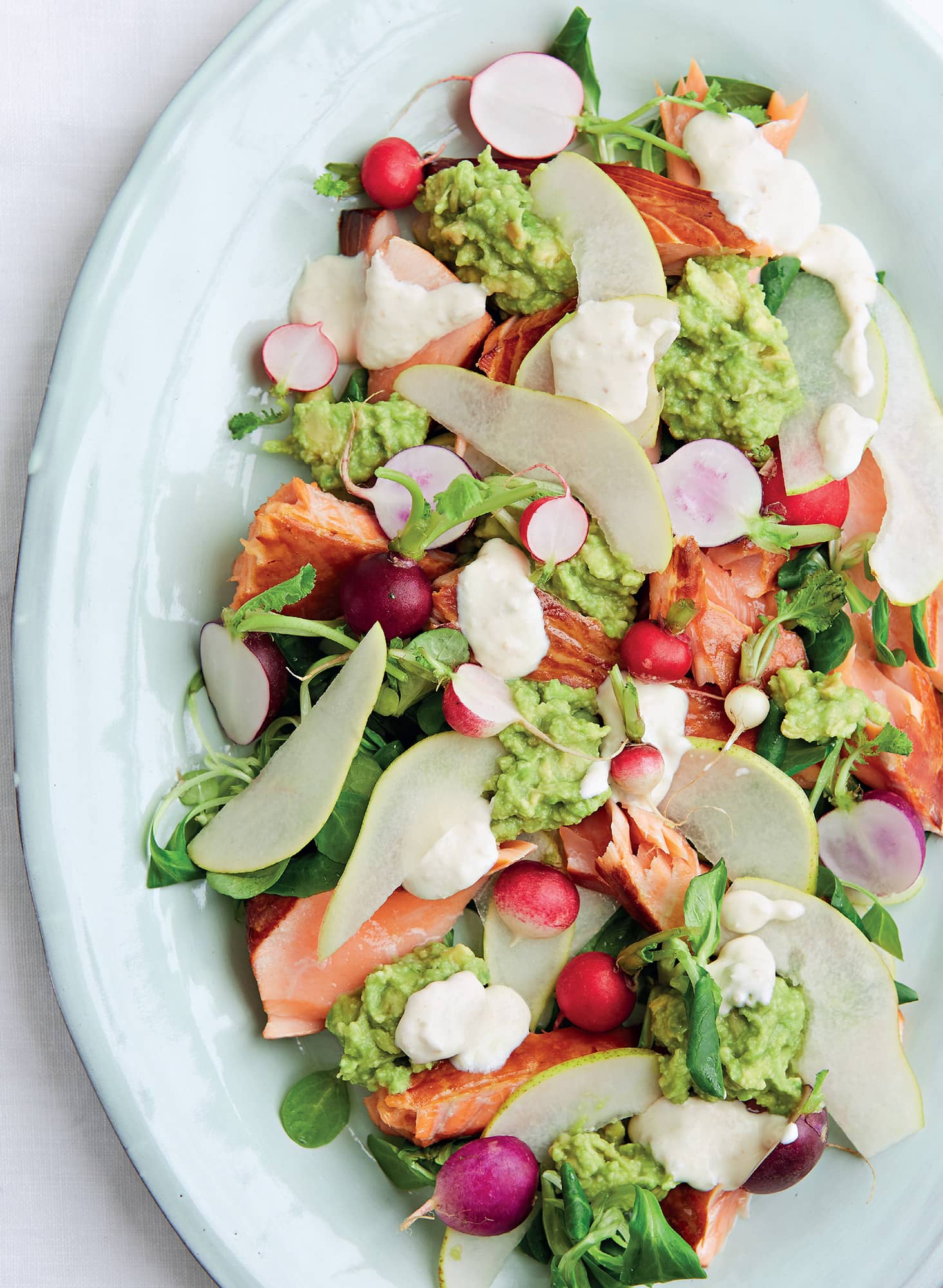
FOR 4 AS A BRUNCH DISH
◁ Hot-smoked salmon, avocado, pear, radish and horseradish cream
WARM OR AT ROOM TEMPERATURE
Hot-smoking is a technique whereby the ingredient is both smoked and cooked. The more familiar ‘Scottish’ cold-smoked salmon is smoked over very low temperatures and has the appearance of being uncooked. This salad can also be made using cold-smoked salmon, which has a more subtle flavour and is generally quite thinly sliced, or indeed the beetroot-cured salmon, but oven-warm chunks of salmon broken over the salad, combined with avocado, pear and horseradish, works best of all. Oily fish, horseradish and avocado truly are a great combination.
INGREDIENTS
600g (1lb. 5oz.) hot-smoked salmon fillet, skin, bones and bloodline removed, at room temperature
1 tsp extra virgin olive oil
100g (3 1/2oz.) radishes
2 avocados
1 juicy lime (or small lemon)
2 tbsp creamed horseradish
3 tbsp crème fraîche (thick sour cream)
1 sweet, ripe pear
2 handfuls salad leaves (I used mâche/corn salad)
[ METHOD ]
Preheat the oven to 150°C (300°F/Gas mark 2). Line a baking sheet with baking parchment.
Lay the salmon on the baking sheet. Brush with the oil and warm in the oven. You don’t want to ‘cook’ it as it’s already cooked; you’re simply warming it up. A fillet 2cm (3/4in.) thick will take about 10–12 minutes.
Meanwhile, place the radishes in iced water for 10 minutes. Drain and cut them in half if they’re large or leave whole.
Remove the flesh from the avocados and place in a bowl. Finely grate 1/4 teaspoon of zest from the lime, then juice it. Add the zest and juice to the avocado and mash together roughly with a fork. Season to taste with salt and pepper.
In another bowl, mix the horseradish into the crème fraîche (thick sour cream) with a pinch of salt.
Cut the pear in half lengthways and remove the core and stem, then thinly slice it.
To serve, lay the salad leaves on your platter or plates. Break the salmon into chunks and sit it on top. Dollop on the avocado. Lay the sliced pear and radishes on top, then drizzle with the crème fraîche (thick sour cream).

FOR 4 AS A LUNCHTIME DISH
◁ Smoked mackerel, beetroot, egg, apple and dill miso mustard dressing
AT ROOM TEMPERATURE
The slightly bitter hints that smoking gives to a piece of fish and a generally sweetish cure is a perfect combination in my view. You can use any smoked fish for this, or even the teriyaki-style mackerel. You can roast the beets in advance to save time, but wear gloves to prevent them staining your hands if you’re using red or purple ones. There are many different styles of miso paste but generally the pale ones, such as shiromiso (white miso), will be sweeter, whereas darker ones, such as hatchomiso, will be more savoury. Taste the dressing to make sure it has a good combination of sweet and savoury.
INGREDIENTS
2 medium beetroot (beets; any colour)
1 tbsp extra virgin olive oil
2 tbsp lemon juice
1 small Chioggia beet (striped beet), for garnish
400g (14oz./about 4 fillets) smoked mackerel fillet
1 apple (choose one that’s crisp, sweet and juicy)
1 handful baby salad leaves (I used mâche/corn salad)
4 eggs, soft boiled and peeled
FOR THE DILL MISO MUSTARD DRESSING
2 tbsp lemon juice
1/2 tsp pale miso paste
1 tsp grain mustard
1/2 tsp English mustard
1/2 tsp caster (superfine) sugar
2 tsp chopped fresh dill
2 tbsp extra virgin olive oil
[ METHOD ]
Preheat the oven to 180°C (350°F/Gas mark 4).
Wash any dirt off the two medium beetroot (beets), then wrap them up together tightly in foil. Place in a roasting dish and bake in the middle of the oven until you can insert a thin sharp knife or skewer through the foil into the centre of the beetroot (beets). This will take anywhere from 45 to 90 minutes depending on their size. Remove from the oven and leave until cool enough to handle. Still wearing gloves, unwrap from the foil and then use your fingers, and a small knife if needed, to rub and peel the skins from them.
Thickly slice the roast beetroot (beets) while still warm and toss with the olive oil, 2 tablespoons of the lemon juice and salt and pepper, then leave to cool.
Peel the Chioggia beet and slice as thin as possible into rings – a mandolin is ideal for this – and put in iced water to crisp it up.
Make the dressing. Mix the lemon juice into the miso paste to form a slurry. Mix in both mustards and sugar. Finally stir in the dill and the olive oil.
Remove the skin, bones and blood line from the mackerel, then break into chunks.
To serve, scatter the salad leaves on four plates. Lay the roast beetroot (beet) slices on top, then the mackerel and Chioggia beets. Cut the eggs in half and julienne the apple, discarding the core, and sit these on top. Spoon over the dressing.
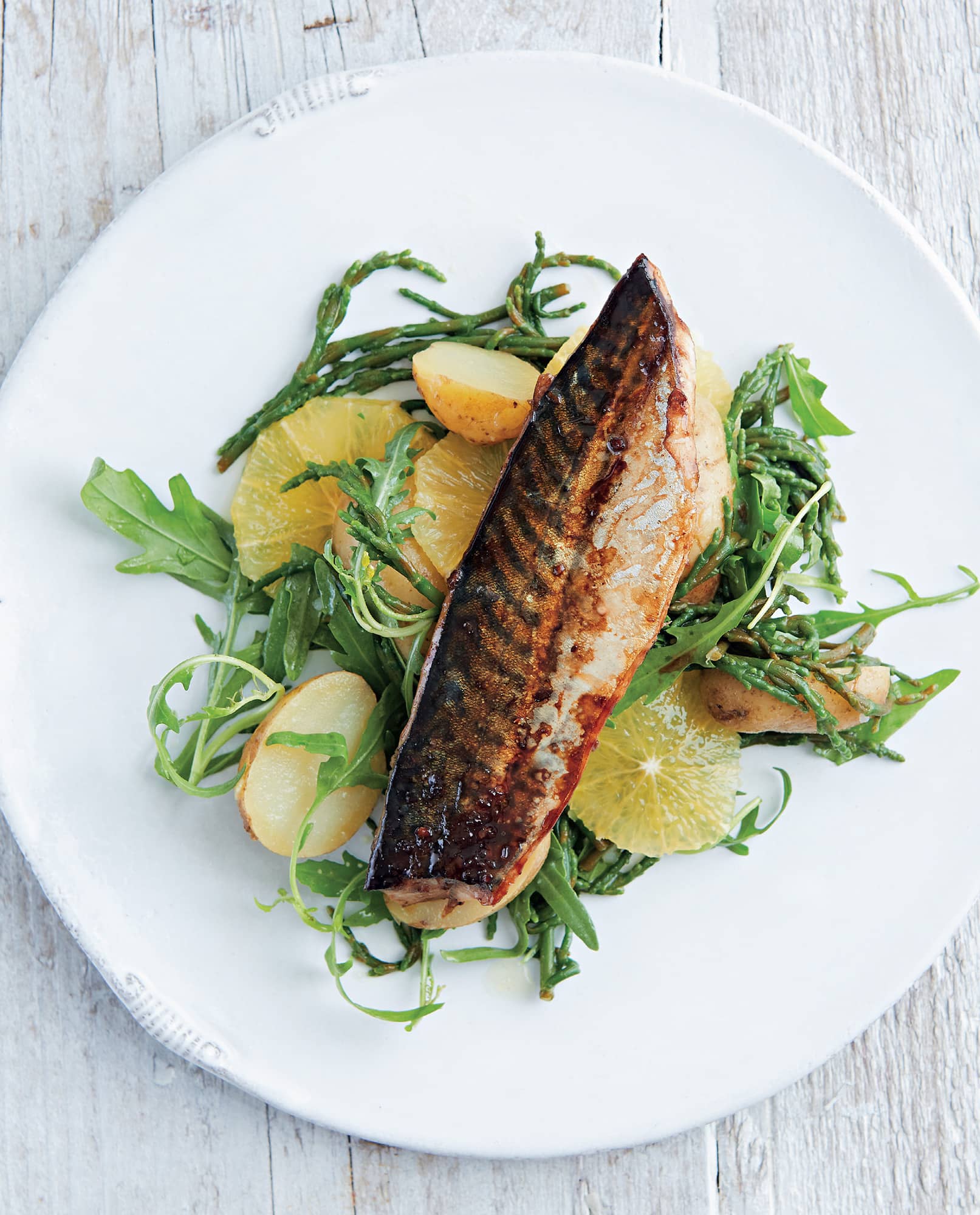
FOR 4 AS A MAIN COURSE
◁ Chilli-chocolate teriyaki mackerel with samphire, Jersey Royals and orange
WARM OR AT ROOM TEMPERATURE
The Japanese technique of teriyaki cooking is something well worth exploring. This sauce, which is sweet (from the mirin, sake or sugar) and salty (from the soy sauce), can be used to brush on or marinate fish, meat or vegetables, and becomes both savoury and sticky when brought into contact with high heat. In 2015, we held a collaborative dinner at The Providores with British chocolate guru Paul A. Young and he created a teriyaki glaze that contained chocolate, which we used on a beef dish. I was inspired, and this recipe takes a bow to Paul. Jersey Royals are very special potatoes grown on the slopes of Jersey’s hillsides. They’re fertilized with seaweed mulch and they’re available for only a short period. If you can’t source them, then use any small waxy potato. Samphire is a marsh vegetable that used to be very seasonal and was often hard to come by but is now farmed and more easily sourced. This way of multi-blanching then marinating it in lemon juice and olive oil is Turkish in style. You can replace it with very fine asparagus, beans or watercress if you wish. Although the samphire may lose some of its vibrant colour, the flavour is brilliant. If mackerel isn’t your thing, then replace it with salmon fillet, tuna, or cod.
INGREDIENTS
2 large mackerel, filleted and small bones removed
500g (1lb. 2oz.) Jersey Royal or other small waxy potatoes
100g (3 1/2oz.) samphire
2 tbsp extra virgin olive oil
1 tbsp lemon juice
2 oranges
1 handful salad leaves (I used rocket/arugula, but watercress would also be lovely)
FOR THE CHILLI-CHOCOLATE TERIYAKI SAUCE
2 tbsp soy sauce
2 tbsp mirin (or use 2 tbsp water and 1 tbsp caster/superfine sugar)
1 tsp runny honey
1 tsp finely chopped or grated ginger
1/2 tsp chilli sauce (Tabasco or a similar fiery sauce)
1 tbsp chopped or grated dark chocolate (60–75% cocoa solids)
[ METHOD ]
Lay the mackerel fillets in a shallow oiled baking dish, skin side down, then cover and place in the fridge.
Make the chilli-chocolate teriyaki sauce. Place the soy, mirin, honey, ginger and chilli sauce in a small pan and slowly bring almost to the boil, but don’t boil it. Take off the heat and leave to cool for 1 minute, then stir in the chocolate until melted and emulsified. Pour into a clean bowl.
Scrub the skins of the potatoes and boil in lightly salted water until cooked, then drain. If they’re small, serve them whole; if they’re larger, cut them in half.
Pick any thick stems from the samphire and discard any discoloured parts. Place in a medium pan and cover with 5cm (2in.) of cold water. Bring to the boil and then drain in a colander. Cook again the same way twice more. Once drained for the third time, place in a bowl and stir in the olive oil and lemon juice. Add the potatoes and mix together.
Cut the peel and pith from the oranges, then slice them 5mm (1/4in.) thick, discarding any pips.
Preheat a grill (broiler) to its highest setting. Remove the fish from the fridge and brush half the teriyaki sauce over the flesh side. Cook under the grill (broiler) until it begins to caramelize. Remove from the heat and carefully turn over the fillets. Brush the skin with the remaining sauce and cook until bubbling and golden.
To serve, lay the orange slices on your plates. Mix the salad leaves with the potatoes and samphire and lay them on top. Carefully lift the mackerel fillets out of the baking dish and sit them on top.
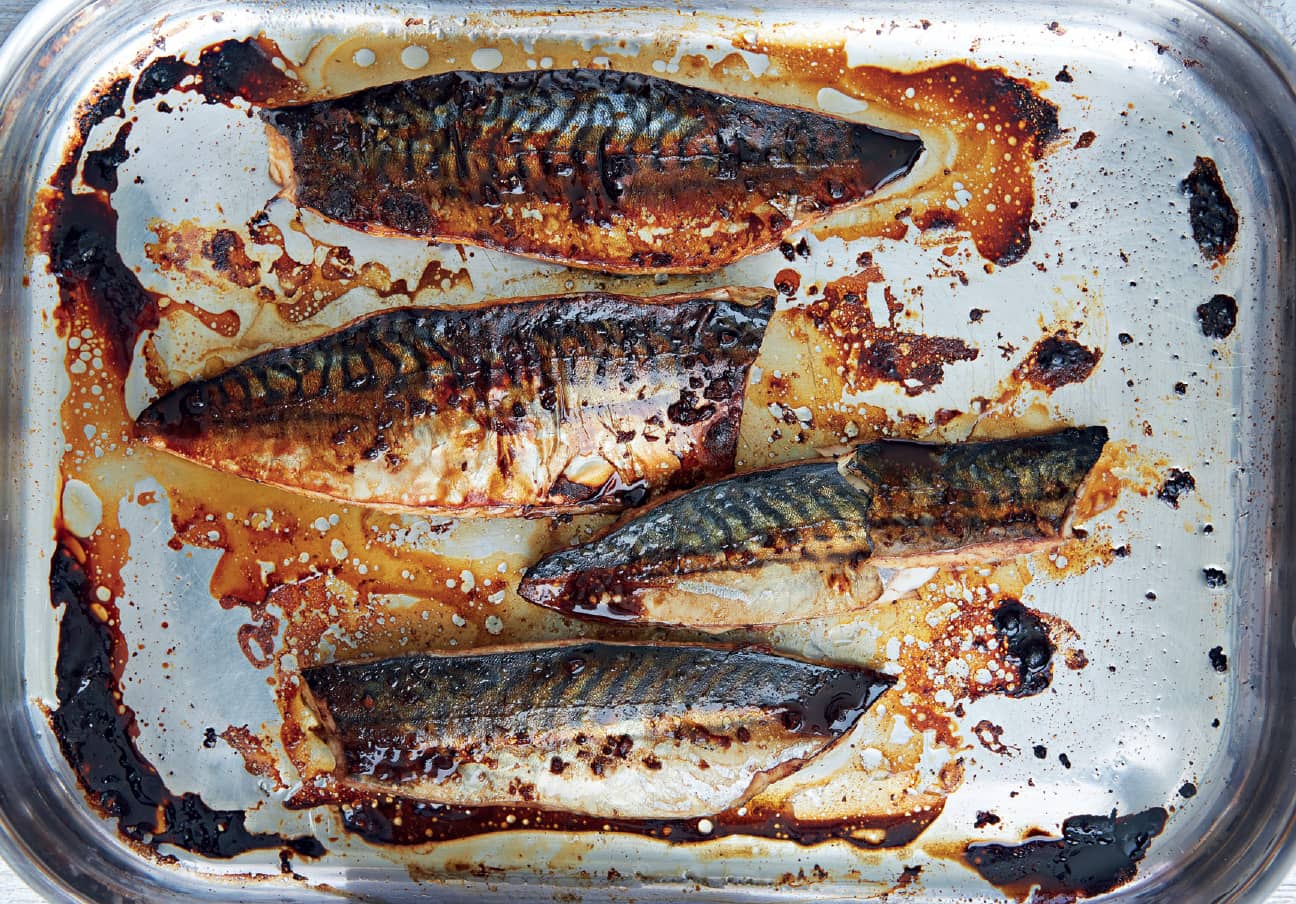

FOR 2 AS A MAIN COURSE OR 4 AS A STARTER
◁ Tuna with coconut, chilli, mango, apple and lime
SLIGHTLY CHILLED
Raw fish salads have been part of my family’s culinary repertoire back in New Zealand for as long as I can remember. Even my step-mum, Rose, a Cockney from London’s East End, got into the swing of things when she and Dad married. Whether it be a Peruvian ceviche or Cook Island’s Ika Mata, or even a jumble of Japanese sashimi, raw fish is delish! Pretty much any fish, so long as it’s very fresh, will work here. The smaller the chunks of fish, or the thinner it’s sliced, the less time it’ll take to marinate. If your limes are very firm, you can get the most juice from them by rolling them firmly on their sides along your worktop for 10 seconds, which helps to crush the cell walls inside the flesh. Alternatively, as odd as this may seem, zap them for 15 seconds in the microwave and then leave to cool.
INGREDIENTS
350g (12oz.) very fresh tuna loin, skin and bones removed
3 tbsp lime juice (or use lemon juice)
1 small red onion, halved and very thinly sliced
1/2 tsp finely grated lime zest
1/2 medium-heat red chilli, finely chopped (use more or less to taste)
1 tsp grated palm sugar or light brown sugar
1 ripe, sweet mango
100ml (scant 1/2 cup) coconut milk
8 stalks coriander (cilantro), leaves picked
1 spring onion (scallion), thinly sliced
1 crisp, sweet apple
2 tbsp desiccated (shredded) coconut, toasted
[ METHOD ]
Cut the fish into cubes about 1 1/2–2cm (3/4in.) square. Mix with half the lime juice and 1/4 teaspoon of flaky salt, then cover and leave in the fridge for 30 minutes.
Briefly rinse the sliced onion under cold water, then mix with the lime zest, chilli, palm sugar and remaining lime juice. Cover and place in the fridge until the fish is ready.
Peel the skin from one half of the mango and cut off the cheek (you’ll need only one cheek). Thinly slice the flesh.
Drain the juices from the fish. Toss gently with the onion mixture, coconut milk, mango, coriander (cilantro) and spring onion (scallion). Cover and leave for 5 minutes in the fridge.
Cut the apple (unpeeled) into juliennes and toss with the toasted coconut.
To serve, give the fish another gentle mix and taste for seasoning, adding extra salt if needed. Divide among your bowls or plates and sprinkle the apple and coconut on top.
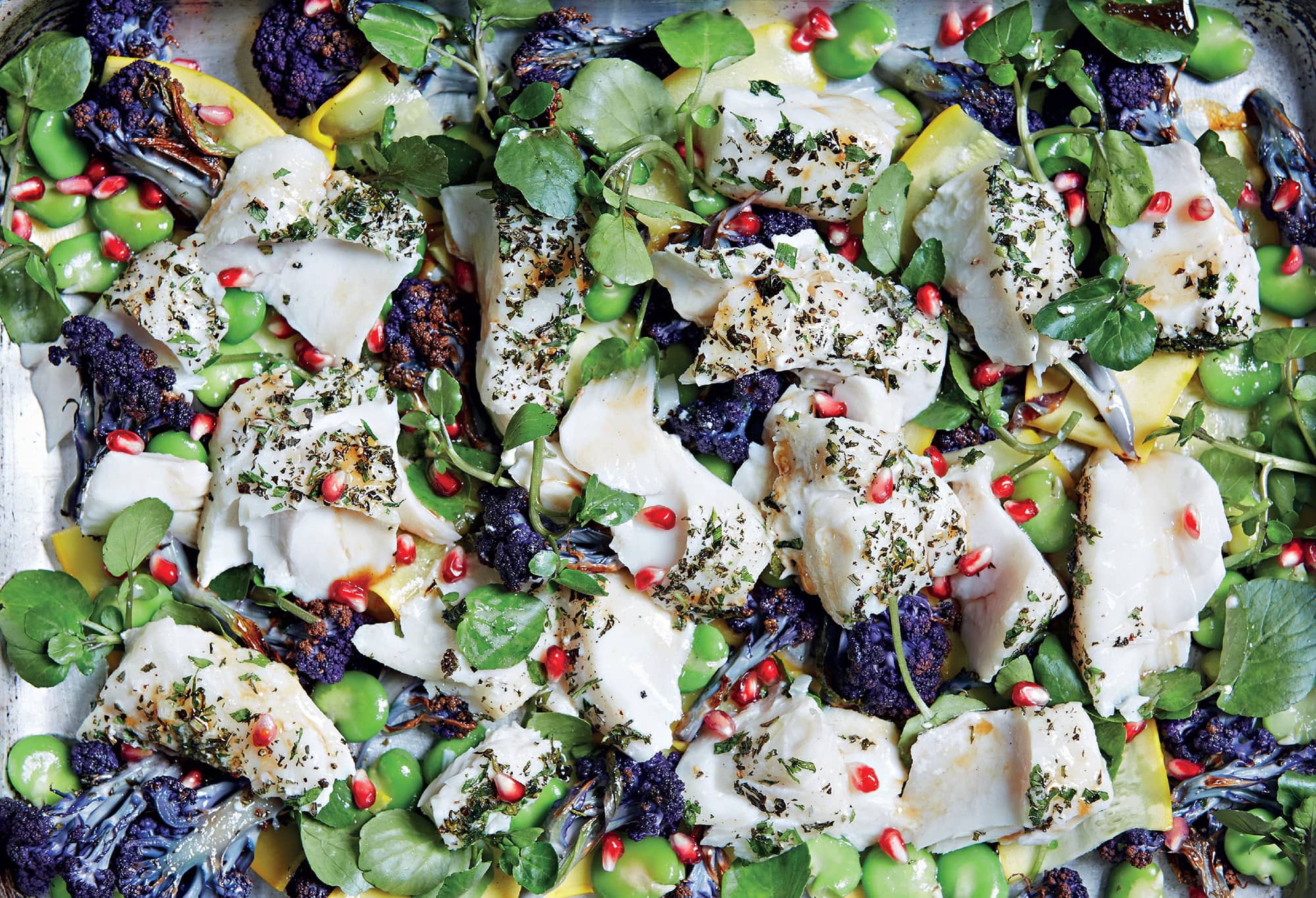
FOR 4 AS A MAIN COURSE
◁ Herb-roast cod and cauliflower, courgettes, broad beans, watercress and pomegranate
WARM OR AT ROOM TEMPERATURE
Fish and cauliflower, both roasted, are a great combination of flavours and textures, especially if the cauliflower is slightly crunchy. There are many varieties of cauliflower, with several colours – in this recipe I used a lovely purple one. I also used yellow courgettes (zucchini) instead of the usual green ones for their colour. As you’re not cooking them, make sure they are firm and fresh. The key to success with this dish is to slightly undercook the fish – it will finish cooking as it rests.
INGREDIENTS
1 medium cauliflower, green leaves and excess stalk removed
2 tbsp mixed fresh herbs, chopped (e.g. thyme, oregano, mint, rosemary, tarragon, parsley)
4 tbsp olive oil
600g (1lb. 5oz.) cod fillet, bones and skin removed
1 tbsp pomegranate molasses
2 tbsp lemon juice
2 courgettes (zucchini), topped and tailed, sliced lengthways 5mm (1/4in.) thick
125g (4 1/2oz.) broad (fava) beans, blanched and refreshed, peeled if large
1 large handful watercress, washed and picked, thick stalks discarded
2 tbsp pomegranate seeds
[ METHOD ]
Preheat the oven to 200°C (400°/Gas mark 6).
Separate the cauliflower florets and place in a roasting dish. Add half the herbs, 1 tablespoon of olive oil, salt and pepper and toss together. Cook in the top of the oven until coloured, about 15–20 minutes.
Brush a roasting dish with 1 teaspoon of the oil and lay the fish in it. Season with salt and pepper, sprinkle with the remaining herbs and drizzle with 2 teaspoons of olive oil. Bake until the fish is just cooked: fillet pieces that are 3cm (1 1/4in.) thick will take about 12 minutes. To test, poke a knife into the centre of one of the thicker pieces and gently prise apart. If it’s translucent, it’s perfect.
Make the dressing. Mix the pomegranate molasses, lemon juice and 1 tablespoon of olive oil together with 1/4 teaspoon of salt. Taste and add more salt if needed.
Toss the sliced courgettes (zucchini) with the remaining 1 tablespoon of olive oil and lightly season with salt.
To serve, toss the cauliflower with the courgettes (zucchini) and broad (fava) beans. Scatter with the watercress. Gently break the fish up using a spoon and fork and place it on top. Drizzle with the dressing and scatter the pomegranate seeds over the top.
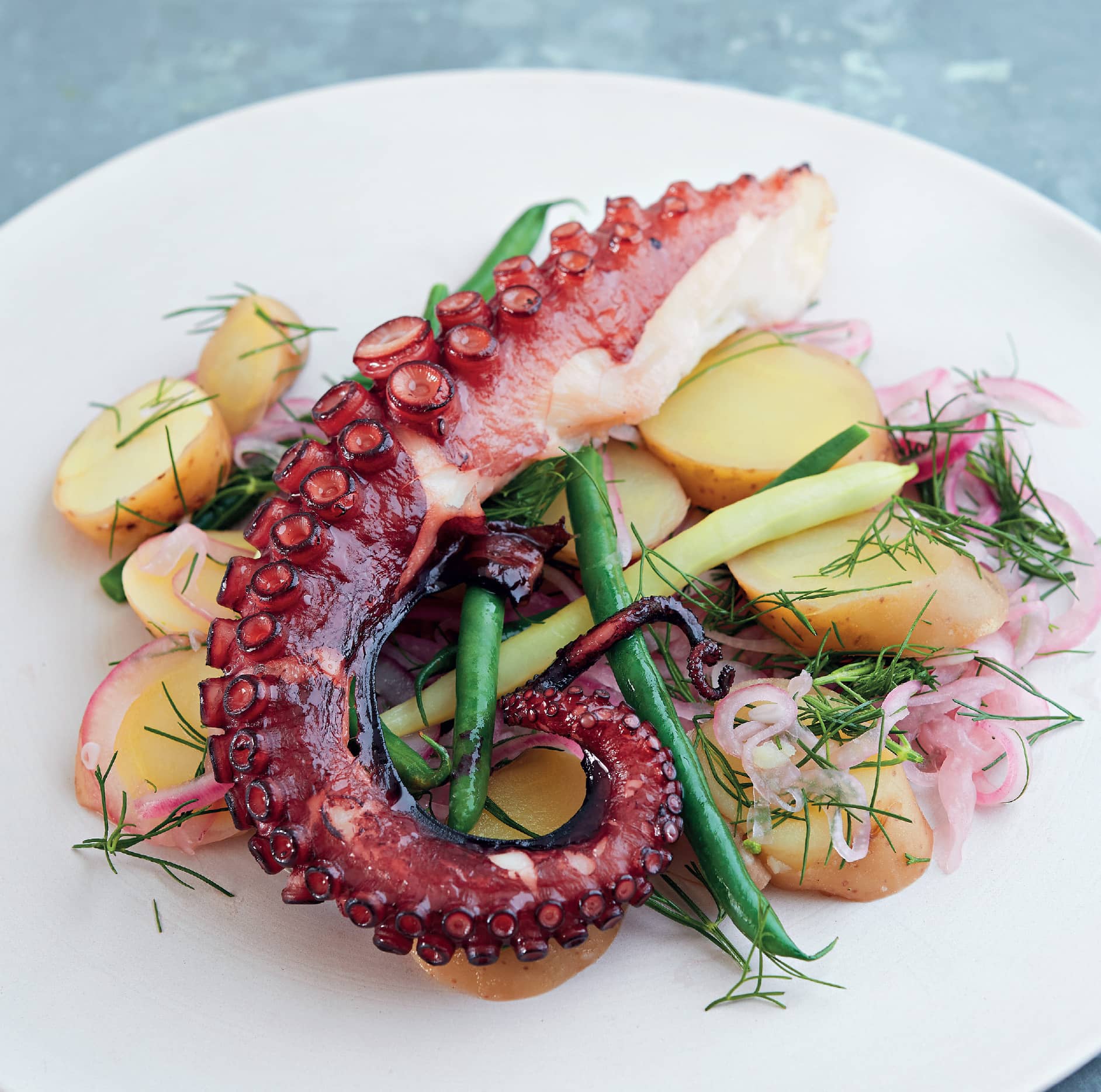
FOR 8 AS A MAIN COURSE
◁ Grilled octopus with potato, bean, onion and dill salad
WARM OR AT ROOM TEMPERATURE
Octopus may seem daunting to cook, but it’s not really that hard and is well worth the effort. It’s fine to use frozen octopus rather than fresh: in fact, some claim that it’s even better because the freezing causes cell walls within the flesh to rupture, which tenderizes it. This technique of slowly baking the octopus, rather than boiling it, comes from Paul Melville, the talented chef running The Providores kitchen when we shot this dish. If you can’t find a large octopus, then use two or three smaller ones instead and reduce the cooking time. You can eat the octopus at room temperature, but I like to serve it warmed up under the grill (broiler) or on the barbecue. This salad teams really well with the watermelon and feta salad.
INGREDIENTS
1 large octopus (about 3kg/6 1/2lb.)
2 red onions, thinly sliced into rings
75ml (5 tbsp) cider vinegar
2 tsp sugar
500g (1lb. 2oz.) waxy potatoes, unpeeled, skins scrubbed
extra virgin olive oil, for reheating the octopus and drizzling at the end
150g (5 1/2oz.) beans, green and yellow, blanched and refreshed
3 tbsp snipped dill
2 lemons, each cut into quarters
[ METHOD ]
First cook the octopus. Preheat the oven to 140°C (275°F/Gas mark 1). Bring a large pan of water to the boil (large enough to hold the octopus easily – or cut it into two or more pieces if this helps) and add 1 teaspoon of fine salt per litre of water. Brush a cake rack with oil, and sit it inside a roasting dish of a slightly larger size, lined with baking parchment. Cut the head off the octopus from just above where the tentacles meet and remove the inner guts. Cut the mouth out of the octopus and remove the beak – these are both located where the tentacles meet. Carefully lower the tentacles and head into the water and boil for 1 minute. Using tongs, remove and lay on the oiled rack. Cover the octopus with baking parchment, tucking it into the dish, then cover this with foil, or an upturned baking dish that sits snugly and will keep the moisture in. Cook in the oven for 3 1/2 hours. Check to see if the octopus is tender: its texture should still be firm, but you should be able to easily cut through a tentacle at the thickest part. Remove and allow to cool. Cut between the tentacles once cooled, and slice the head into strips.
While the octopus is cooking, toss the onions with 4 tablespoons of the cider vinegar, the sugar and 1/2 teaspoon of salt. Cover and leave to marinate in the fridge, stirring several times.
Boil the potatoes in lightly salted water until cooked, then drain and thickly slice as soon as they are cool enough to handle. Toss with the remaining 1 tablespoon of vinegar. Keep at room temperature.
Preheat a grill (broiler) to high. Lightly oil a baking sheet and lay the tentacles and sliced head on it, then brush them with a little extra oil. Place under the grill (broiler) and cook until the octopus skin begins to bubble and almost blister.
To serve, drain half the liquid from the onions, then toss them with the potatoes, sliced octopus head, beans and dill. Divide among your plates, lay an octopus tentacle on top along with any juices from the baking sheet. Drizzle with a little extra virgin olive oil and serve with the lemon wedges.

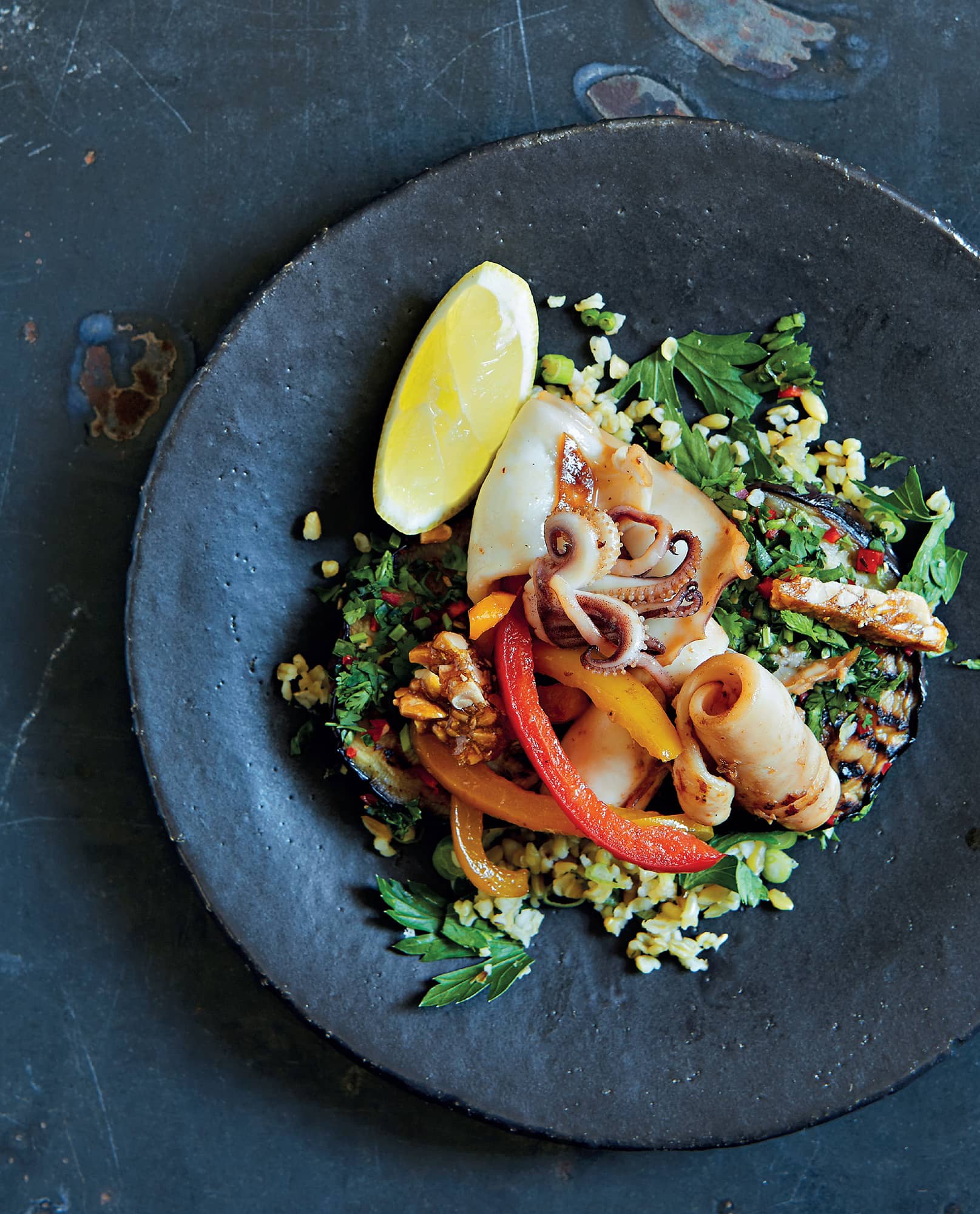
FOR 6 AS A STARTER
◁ Grilled squid and peppers, freekeh, chillied aubergine and sesame peanut brittle
WARM OR AT ROOM TEMPERATURE
This lovely flavoursome salad can be served hot off the grill or barbecue, or at room temperature, so it’s the perfect meal to cook last minute at a barbecue, or at home, finished before your guests arrive to avoid all that smokiness filling the house. The perfect-sized squid tubes to use will be about 12–15cm (5–6in.) long, but you can make do with much smaller ones or even larger ones – just adjust your cooking times accordingly. The sesame peanut brittle is very easy to make and keeps for 2 weeks if stored in a cool place in an airtight container.
INGREDIENTS
1kg (2lb. 4oz.) uncleaned squid
2 garlic cloves, peeled and thinly sliced
2 (bell) peppers (red, orange or yellow), cut in half, stalk and seeds removed, then sliced into strips
3 tbsp olive oil
200g (7oz./1 cup) freekeh, rinsed and drained
1 handful flat-leaf (Italian) parsley leaves
2 spring onions (scallions), thinly sliced
2 juicy lemons
1/4 tsp finely grated lemon zest (from one of the above lemons)
1 aubergine (eggplant), sliced into 1cm-thick rings
1 medium-heat red chilli, finely chopped
1 small handful coriander (cilantro), including stalks, shredded (or use parsley, fennel or dill fronds)
2 tbsp soy sauce
6 tbsp crushed sesame peanut brittle
[ METHOD ]
First clean your squid. Separate the heads from the tentacles and remove the wings. Split the heads in half lengthways and using a knife, scrape out any of the inner workings of the heads. Remove the beaks from the centre of the legs. Peel off any membrane from the wings and head and place the cleaned squid and tentacles into a colander and leave to drain for a few minutes. Pat dry with absorbent kitchen paper and put in a dish. Add the garlic, sliced peppers and 1 tablespoon of olive oil and mix together, then cover the dish and leave for 30 minutes in the fridge.
Meanwhile, pour water into a medium pan until three quarters full and bring to the boil. Add the freekeh and 1 teaspoon of salt, and cook over a rapid simmer for 20 minutes or so until cooked. It should have a little bite to it still but not be crunchy. Drain into a sieve and leave to cool. Once cooled, mix with 1 tablespoon of olive oil, the parsley, spring onions (scallions), the juice of 1 lemon and the lemon zest. Taste for seasoning.
Cut the other lemon into four or six segments.
Brush the aubergine (eggplant) slices with the remaining 1 tablespoon of olive oil and season lightly. Cook on a griddle, or in a heavy-based frying pan (skillet) placed over a medium–high heat, until both sides are golden and marked, about 2 minutes on each side. Once cooked, put on a baking sheet and sprinkle with half the chopped chilli and coriander (cilantro). Turn over and sprinkle with the remainder and a little salt and pepper.
Turn the heat almost up to full, then cook the squid and peppers together (using the same pan or griddle you used to cook the aubergines/eggplant – there is no need to clean it), turning as the squid cooks and curls up. Cook in two batches so you don’t overcrowd the pan or griddle, which will lower the temperature. Make sure you don’t overcook the squid either, or it will become tough. Once the second lot of squid and peppers are almost cooked, pour in the soy sauce, return the first batch and cook until the soy sauce has evaporated, tossing everything. Turn off the heat and place the squid and peppers in a bowl.
To serve, layer the aubergine (eggplant) with the freekeh on a platter or plates. Pile on the squid and peppers. Scatter with the crushed sesame peanut brittle and tuck a lemon wedge in.
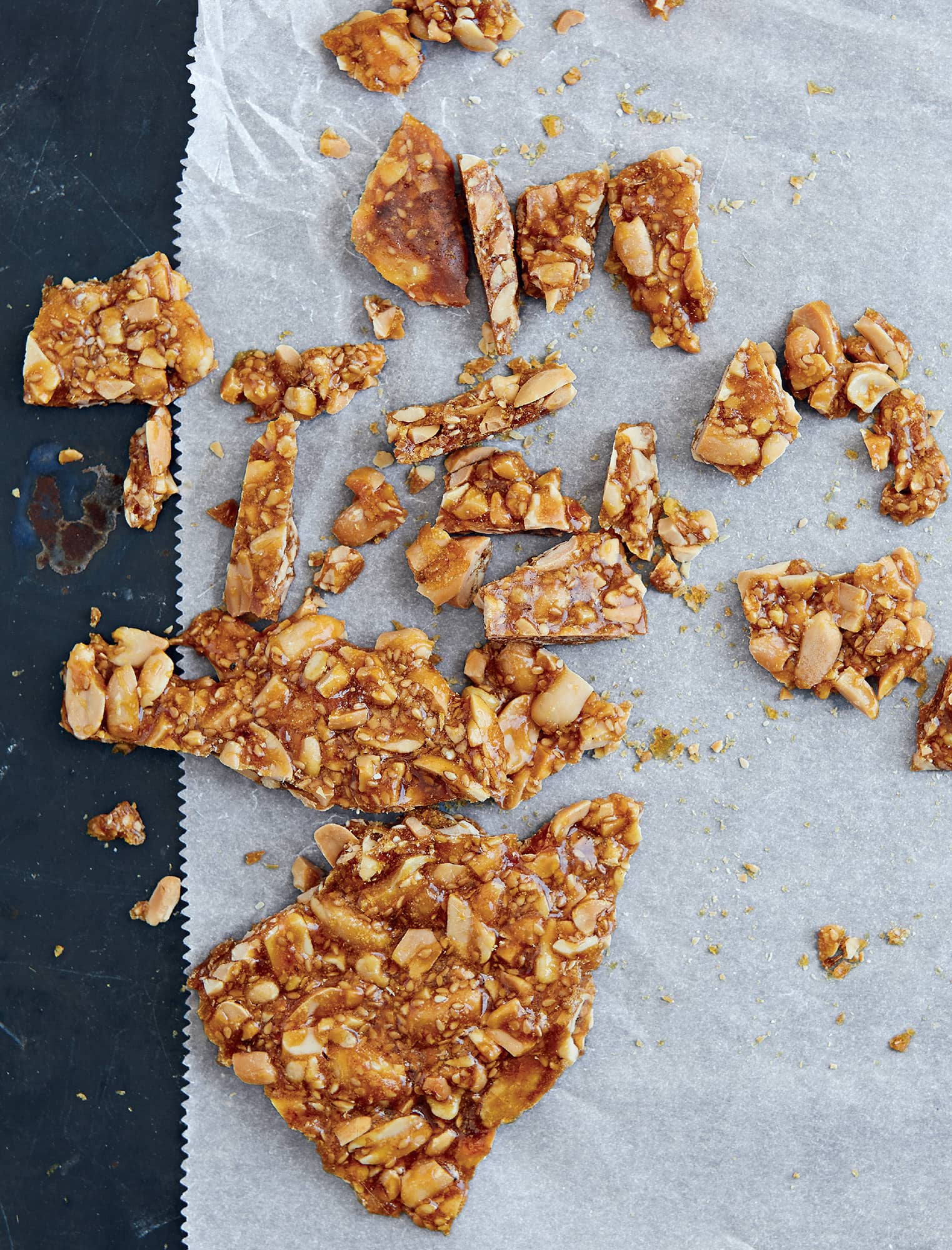
◁ Sesame peanut brittle
INGREDIENTS
100g (3 1/2oz./2/3 cup) roasted peanuts, salted or unsalted – just adjust the amount of salt you add
2 tbsp sesame seeds, toasted
150g (5 1/2oz./3/4 cup) caster (superfine) sugar
[ METHOD ]
Line a baking dish or heatproof tray with baking parchment.
Mix the peanuts, sesame seeds and 1/4 teaspoon of flaky salt together.
Place the sugar in a clean, dry saucepan and melt over a medium heat without stirring. You can shake the pan gently to ensure it melts and colours evenly, but don’t stir: if the sugar crystallizes, you’ll have to start again.
Once the sugar has become a dark caramel colour, turn off the heat and add the peanut mixture all at once. Stir to coat the nuts with caramel, then tip onto the baking parchment, press as flat as you can and leave to cool. It will be really hot so do be careful.
You can either break this up with your fingers, carefully chop it with a sharp knife while still a little warm, or place it inside a strong plastic bag and bash with a rolling pin until crushed. Store the brittle in an airtight container.
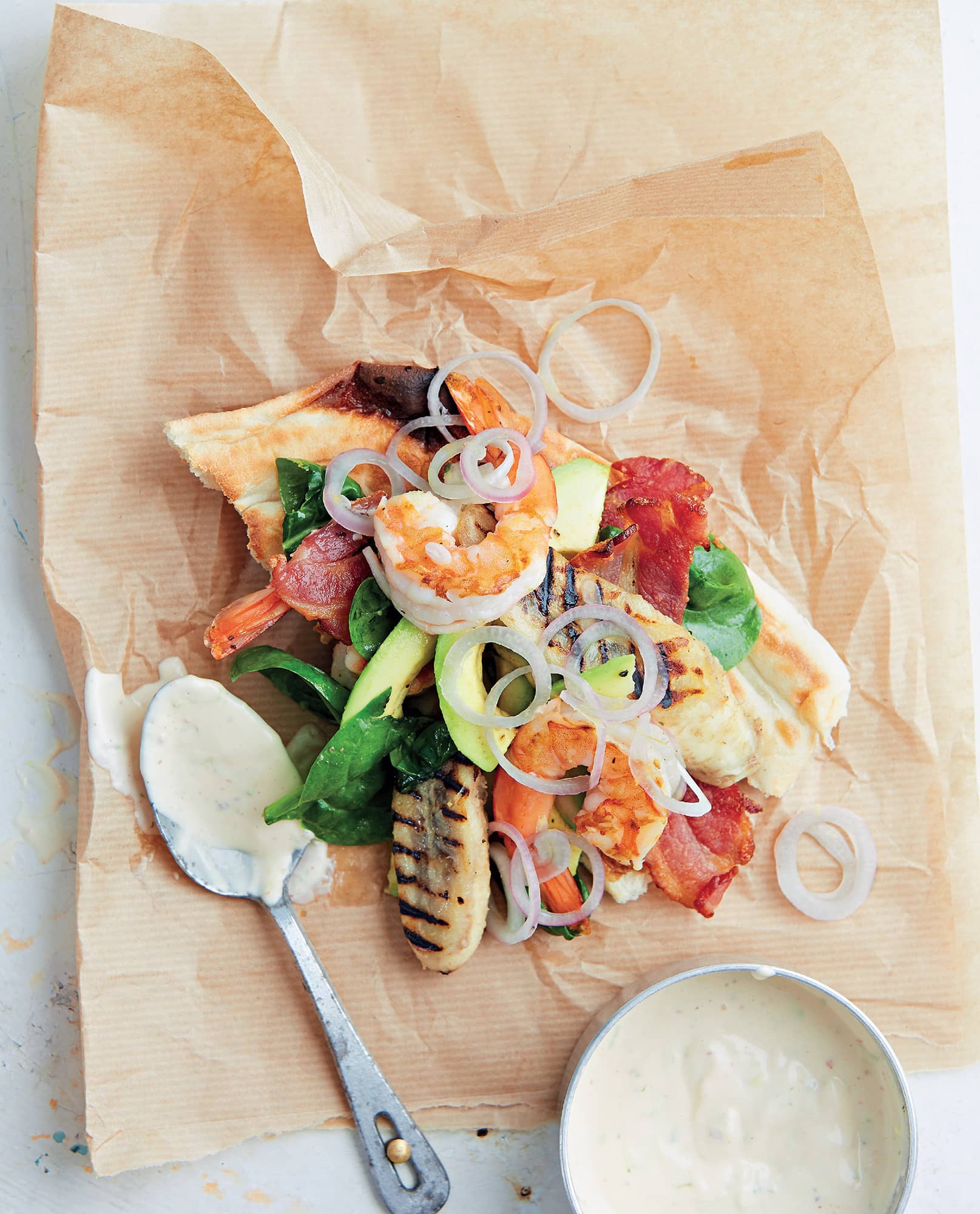
FOR 2 AS A BRUNCH MAIN COURSE
◁ Grilled prawns, bacon and bananas, avocado and chilli mayonnaise
WARM
Prawns (shrimp) and bacon make a great combination, especially if the bacon is smoked, slightly crisp when cooked and deliciously salty. Fresh, high-quality prawns (shrimp) are a little ‘crunchy’ in texture, rich and slightly sweet, and the two combined are terrific. Add grilled (broiled) banana (a childhood breakfast favourite of mine served with bacon) to the mix for the perfect casual brunch or supper pick-me-up! You can use either the mayonnaise or egg-free milk aioli as the base for the chilli mayonnaise.
INGREDIENTS
250g (9oz.) raw peeled prawns (shrimp) (500g/ 1lb. 2oz. unpeeled weight)
1 ripe banana
2 tbsp vegetable oil
1 large shallot, thinly sliced into rings
1/4 tsp finely grated lime zest
2 tsp lime juice
4 tbsp mayonnaise or egg-free milk aioli
chilli sauce, to taste
4 rashers smoked streaky (pork belly) bacon
2 large slices bread for toasting (I used Turkish flat bread)
1 avocado
1 generous handful baby spinach or other salad leaves
[ METHOD ]
Peel the prawns (shrimp) but keep the tails on. (You can freeze the shells for making a delicious bisque at some later point.) Run a small sharp knife along the ‘spine’ of the tail and remove and discard the digestive tract.
Peel the banana and slice on an angle 5mm (1/4in.) thick. Gently toss or brush both the prawns (shrimp) and the banana with the oil.
Rinse the shallot rings in cold water for a minute, separating them, then drain. Mix with the lime zest and 1 teaspoon of the juice.
Mix the mayonnaise with the remaining 1 teaspoon of lime juice and the chilli sauce to taste. Check for seasoning, adding salt if needed.
You can cook this either under the grill (broiler), in a frying pan (skillet) or on a barbecue. Heat the grill (broiler) or pan (skillet) medium–high and cook the bacon until crisp and bubbling with fatty juices. Remove from the heat and keep warm nearby. Cook the prawns (shrimp) for no more than 60 seconds on each side, depending on their size. Sit the prawns (shrimp) with the bacon and keep warm. Cook the banana on both sides until beginning to caramelize. It’ll be quite soft when you turn it over, so treat it gently. Remove from the heat.
Toast the bread. Peel the avocado, remove the stone (pit), scoop out the flesh and cut into wedges.
To serve, gently mix the prawns (shrimp), bacon, banana, shallots, avocado and spinach together, then pile on top of the toast. Serve with the chilli mayonnaise.
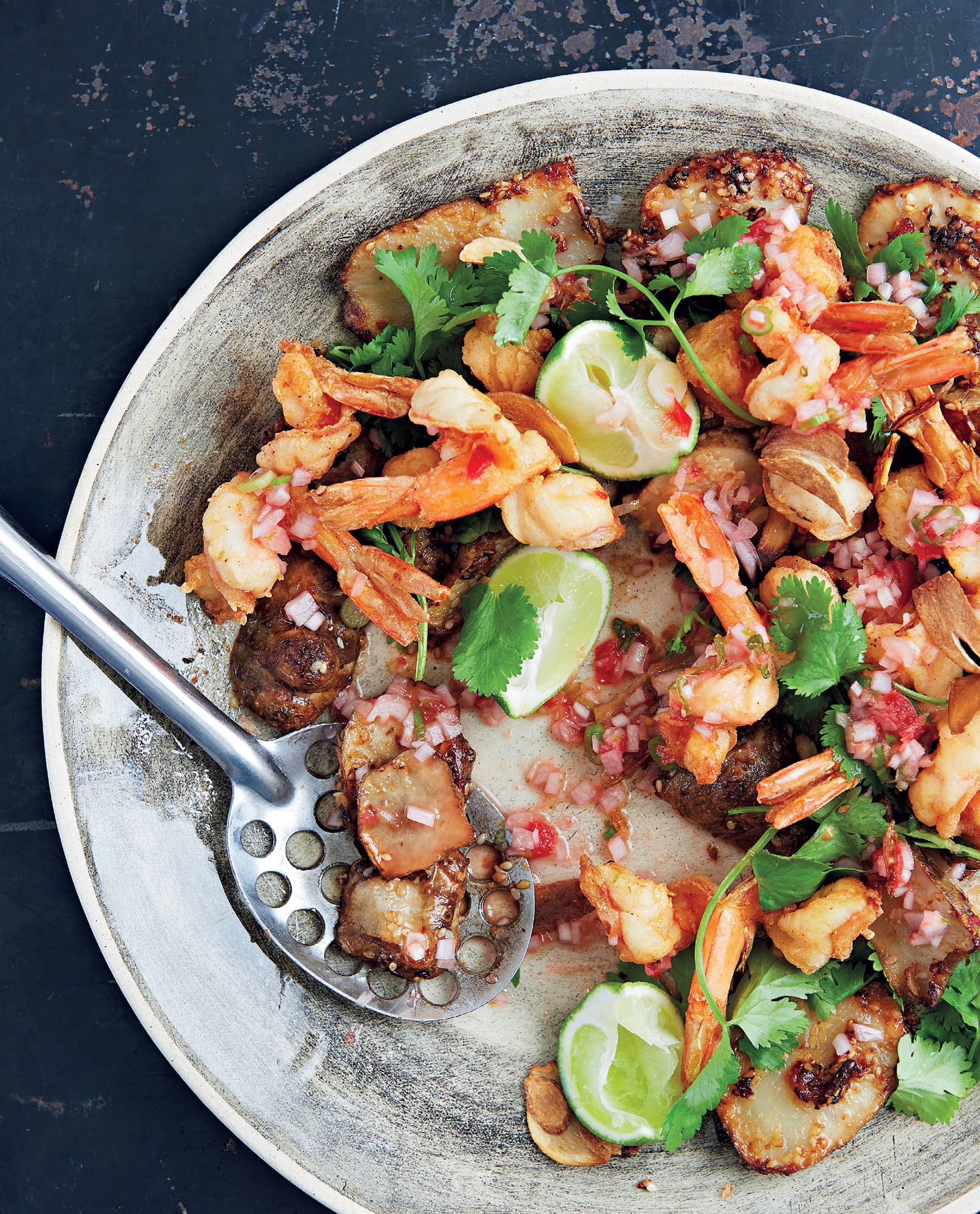
FOR 4–6 AS A STARTER
◁ Salt and Sichuan pepper prawns, miso-roast Jerusalem artichokes, crispy garlic and umeboshi dressing
WARM
This can easily be scaled up to make it a starter for many people, or served as a main course for two alongside a crisp green salad. You need to use smallish raw prawns (shrimp); don’t use cooked ones. Sichuan pepper is a tongue-numbing spice from China, also called Sansho pepper in Japan. It’s an acquired taste and, though I love it, I have several friends who can’t bear it. If you can’t source it, then use black pepper instead. If Jerusalem artichokes aren’t in season, use chunks of celeriac, sweet potato or pumpkin. Umeboshi are salted sour Japanese fruits called ‘ume’ (they’re not plums as many people think, but more closely related to the apricot). You can buy them whole in jars, or as a paste. If you can’t find them whole then use 2 teaspoons of paste.
INGREDIENTS
500g (1lb. 2oz.) Jerusalem artichokes, skins scrubbed (or peeled if really dirty)
1 tbsp miso paste (I used shiromiso)
1 tbsp olive oil
2 tsp sesame seeds
4 whole umeboshi, pitted and roughly chopped
1 large shallot, finely chopped
1 spring onion (scallion), thinly sliced
2 tsp finely chopped or grated ginger
1 tbsp sugar
1/2 tsp finely grated lime zest (or lemon zest)
75ml (5 tbsp) lime juice (or use lemon juice)
2 tsp fish sauce
1 tbsp Sichuan peppercorns
2 tbsp flaky salt
3 tbsp rice flour (or use cornflour/cornstarch, tapioca flour or even wheat flour)
vegetable oil for deep-frying
6 garlic cloves, thinly sliced
500g (1lb. 2oz.) peeled headless raw prawns (shrimp) – butterfly them by splitting them in two, but keeping them connected at the tail
1 handful coriander (cilantro), picked, stalks cut into 2cm (3/4in.) lengths
1 large juicy lime, quartered
[ METHOD ]
Preheat the oven to 180°C (350°F/Gas mark 4). Line a roasting dish with baking parchment.
Slice the Jerusalem artichokes 5mm (1/4in.) thick. Mix the miso with the olive oil, sesame seeds and 2 teaspoons of warm water. Toss with the artichokes, then place in the roasting dish and bake until golden, about 20 minutes. Stir from time to time so they become evenly coloured.
Make the dressing. Mix together the umeboshi, shallot, spring onion (scallion), ginger, sugar, lime zest and juice and fish sauce.
For the salt and pepper mixture, dry-toast the Sichuan peppercorns in a frying pan (skillet) over a medium–high heat for 1–2 minutes until fragrant, shaking the pan as they cook. Add the flaky salt and cook for an additional 20 seconds, gently shaking the pan the whole time. Tip into a mortar and pound until reasonably fine, but not powdered, with a pestle. Once cooled, mix into the rice flour in a bowl.
Pour oil into a wok or deep-sided pan to a depth of 1cm (1/2in.) and heat until it begins to smoke a little (at about 160°C/325°F).
Scatter the sliced garlic onto the surface of the oil as quickly as you can to enable even cooking, stirring the oil gently as the garlic becomes golden. If it turns dark brown it will likely taste bitter and burnt, but too pale and it won’t become crispy. Once done, remove with a slotted spoon and drain on absorbent kitchen paper.
To fry the prawns (shrimp), top up the oil to a depth of about 5cm (2in.) and increase the temperature to 180°C (350°F). Pat the prawns (shrimp) dry with absorbent kitchen paper. Toss them in a bowl with the Sichuan pepper flour and leave for 30 seconds. Shake off the excess flour and place the prawns (shrimp) on a tray. Fry them in two or three batches until golden and crisp, then drain on absorbent kitchen paper. Don’t overcrowd them in the pan or the oil temperature will drop and they will taste oily.
To serve, place the artichokes on your platter or plates. Scatter on the coriander (cilantro) stalks, then lay the prawns (shrimp) on top. Spoon on the dressing, scatter with the coriander (cilantro) leaves and crispy garlic and tuck in the lime quarters.
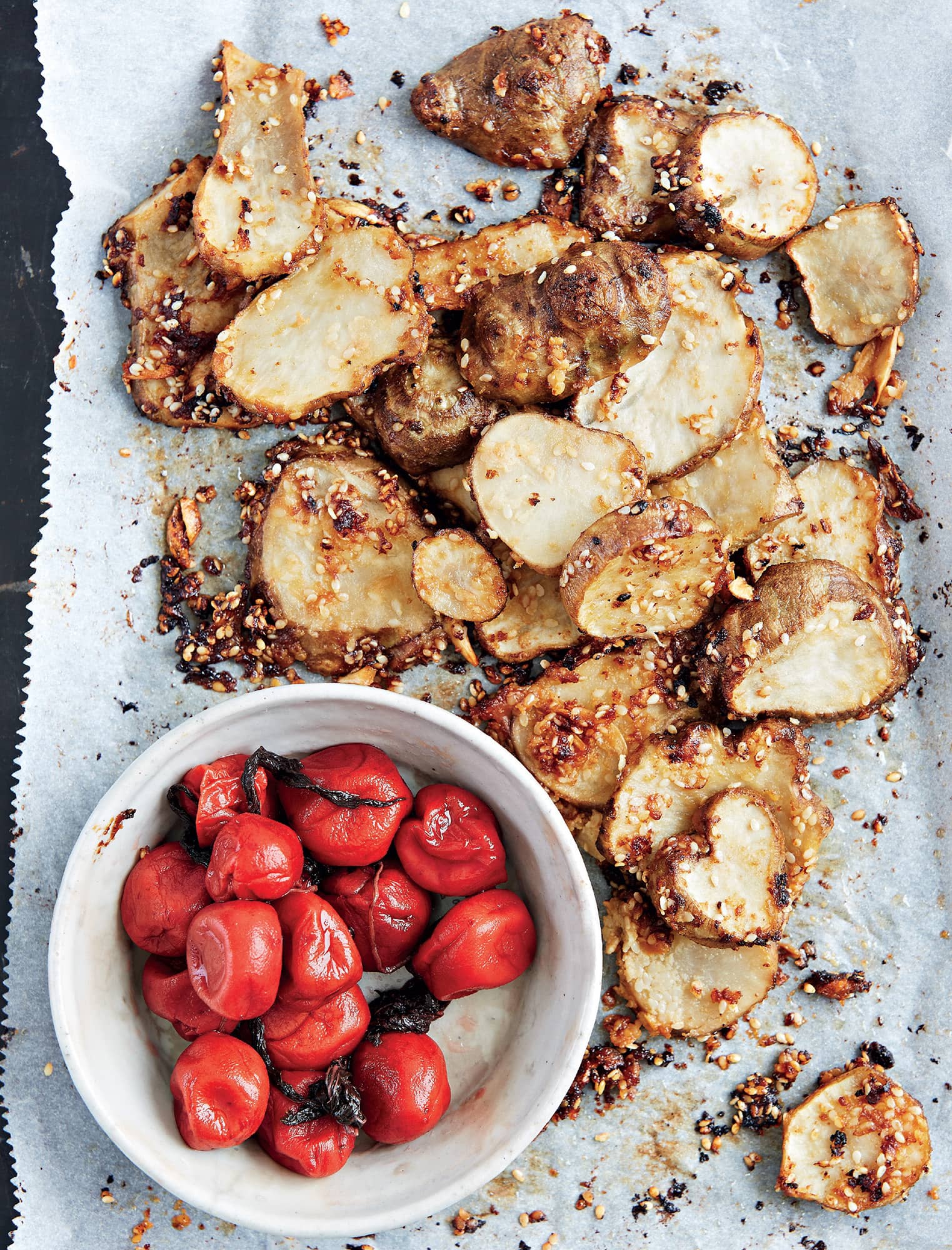
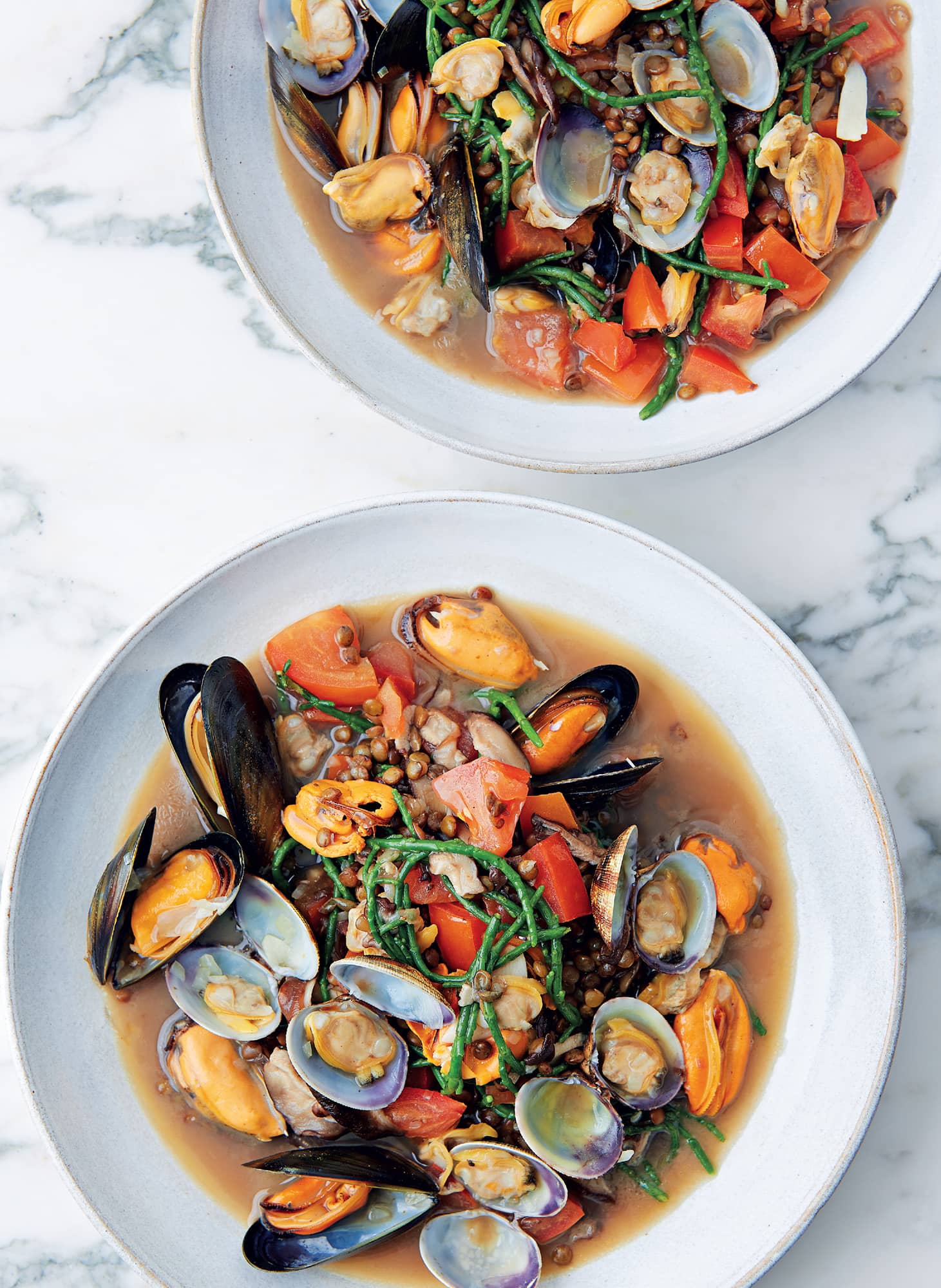
FOR 4–6 AS A LUNCHTIME DISH OR GENEROUS STARTER
◁ Clams, mussels, puy lentils, coconut, samphire, tomato and shiitake mushrooms
WARM
The broth created when making this dish is so delicious, it’s almost worth making it just for that, so make sure you serve it with some bread to mop up the delicious juices. You’ll also need to serve your guests with finger bowls as they’ll need to be hands-on to enjoy this.
INGREDIENTS
100g (3 1/2oz./1/2 cup) puy lentils
2 large shallots, finely chopped
4 garlic cloves, sliced
2 tbsp sesame oil
1kg (2lb. 4oz.) clams, rinsed well and cleaned, opened or damaged ones discarded
1kg (2lb. 4oz.) mussels, rinsed well, cleaned of beards, opened or damaged ones discarded
400ml (13 1/2fl. oz.) can coconut milk (unsweetened)
4 tomatoes, halved, seeds squeezed out, diced
300g (10 1/2oz.) shiitake mushrooms, thickly sliced, stalks discarded
100g (3 1/2oz.) samphire, any woody stems discarded
[ METHOD ]
First cook the lentils. Rinse them in a sieve for 15 seconds, then put in a saucepan and cover with 5cm (2in.) of water. Add 1/2 teaspoon of salt. Bring to the boil then cook at a rapid simmer until done, which will take about 20 minutes. Drain.
Heat the sesame oil in a large pan on a medium heat and fry the shallots and garlic until caramelized. Add the shellfish and cook for 1 minute, gently stirring the whole time. Stir in the coconut milk and bring to the boil. Put a lid on and cook for 3 minutes. Give the pan a stir and then keep cooking only until the clams and mussels are open. Scoop them out into a colander, discarding any that haven’t opened. Put the coconut broth back on a high heat and reduce by half. Add the tomatoes, shiitake mushrooms and samphire and boil for 1 minute.
Save a handful of the best-looking clams and mussels in their shells (I allowed six clams and four mussels per person). Remove the flesh from the remaining ones and discard the shells.
To serve, mix all the shellfish into the broth and taste for seasoning, adding salt and coarsely ground black pepper as needed. Ladle into warmed bowls.
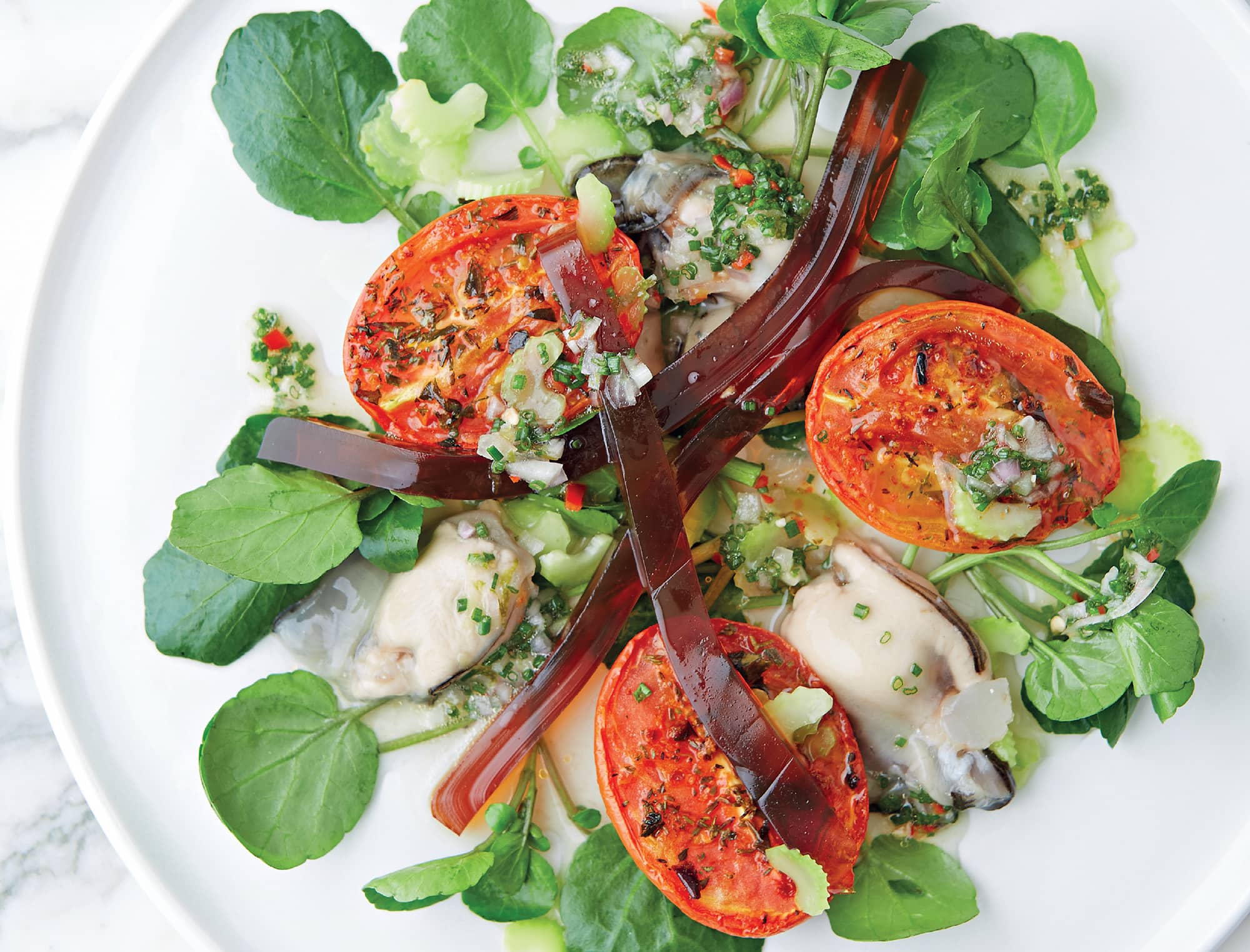
FOR 4 AS A STARTER
◁ Oysters, roast tomatoes, celery, dashi jelly and chillied sesame dressing
SLIGHTLY CHILLED
I love this salad served icy cold, made with freshly shucked oysters. However, I’ve also served it in cooler months using oysters that I’ve poached briefly in a mixture of dashi and cream. To do that, make double the quantity of dashi given here and combine half of it with an equal amount of coconut milk or cream. To set the jelly, I use agar powder, which is a seaweed-based ‘vegetarian gelatine’, but you can replace it with regular gelatine. The dashi stock makes more jelly than you need but it’s very hard to make any less. Make your jelly first, and keep it in the fridge for up to 5 days. You can also buy dashi granules from Japanese stores. Allow three or four oysters per person, depending on their size.
INGREDIENTS
6 plum tomatoes, halved lengthways
1/2 tsp finely chopped thyme
1/2 tsp finely chopped tarragon
1/4 tsp dried chilli flakes
1 tbsp extra virgin olive oil
1 handful watercress, picked
12–16 oysters, freshly shucked
2 young celery stalks (from the centre of the bunch), thinly sliced
FOR THE DASHI JELLY
10–12g kombu seaweed (a 10cm x 12cm/4 x 5in. piece), briefly rinsed under warm water and wiped dry
3 1/2 tbsp soy sauce
3 1/2 tbsp mirin
10g (1/3oz.) dried shaved bonito
1 heaped tsp (4g) agar powder
FOR THE CHILLIED SESAME DRESSING
1 shallot, finely chopped
1/4 medium-heat red chilli, finely chopped including the seeds (more or less to taste)
1/2 tsp finely grated lime zest
4 tbsp lime juice
2 tbsp mirin (or use 1 tbsp caster/superfine sugar and 1 tbsp water)
1 tbsp sesame oil
2 tsp fish sauce (or use light soy sauce or 1/4 tsp salt)
2 tbsp finely snipped chives
[ METHOD ]
Make the dashi jelly at least 3 hours before serving. Place the kombu, soy sauce, mirin and 400ml (1 2/3 cups) of water into a pan and very slowly bring almost to the boil – make sure it doesn’t actually boil though. Turn off the heat and add the bonito. Stir briefly, then let it settle for 15 minutes. Strain through a fine sieve into a clean pan – you should have 400ml (1 2/3 cups) of liquid. Bring it to a rapid simmer, then remove from the heat and sprinkle the agar powder on the surface, gently whisking it in. Put the pan back on the heat and slowly bring it to a gentle boil, gently whisking the whole time, and cook for 1 minute. Pour into a heatproof dish and leave to set and cool. (Interestingly, agar jellies will set while still warm.) Cover and chill in the fridge for up to 5 days. Cut the jelly into long batons, thin strips or any other shape that takes your fancy.
Preheat the oven to 160°C (325°F/Gas mark 3). Line a roasting dish with baking parchment.
Place the tomato halves in the roasting dish, cut side facing up. Scatter evenly with the thyme, tarragon and chilli flakes. Drizzle on the olive oil and lightly season with salt. Bake for 45 minutes or so until they have coloured and slightly shrunk. Remove from the oven and leave to cool.
Make the chillied sesame dressing. Place the shallot, chilli, lime zest and juice, mirin, sesame oil and fish sauce in a jar and shake well. Leave in the fridge until you need it. Just before using, add the chives and shake again.
To serve, lay the watercress on your plates, sit the tomatoes on top and tuck in the oysters. Scatter over the celery and top with strips of dashi jelly. Spoon on the dressing.
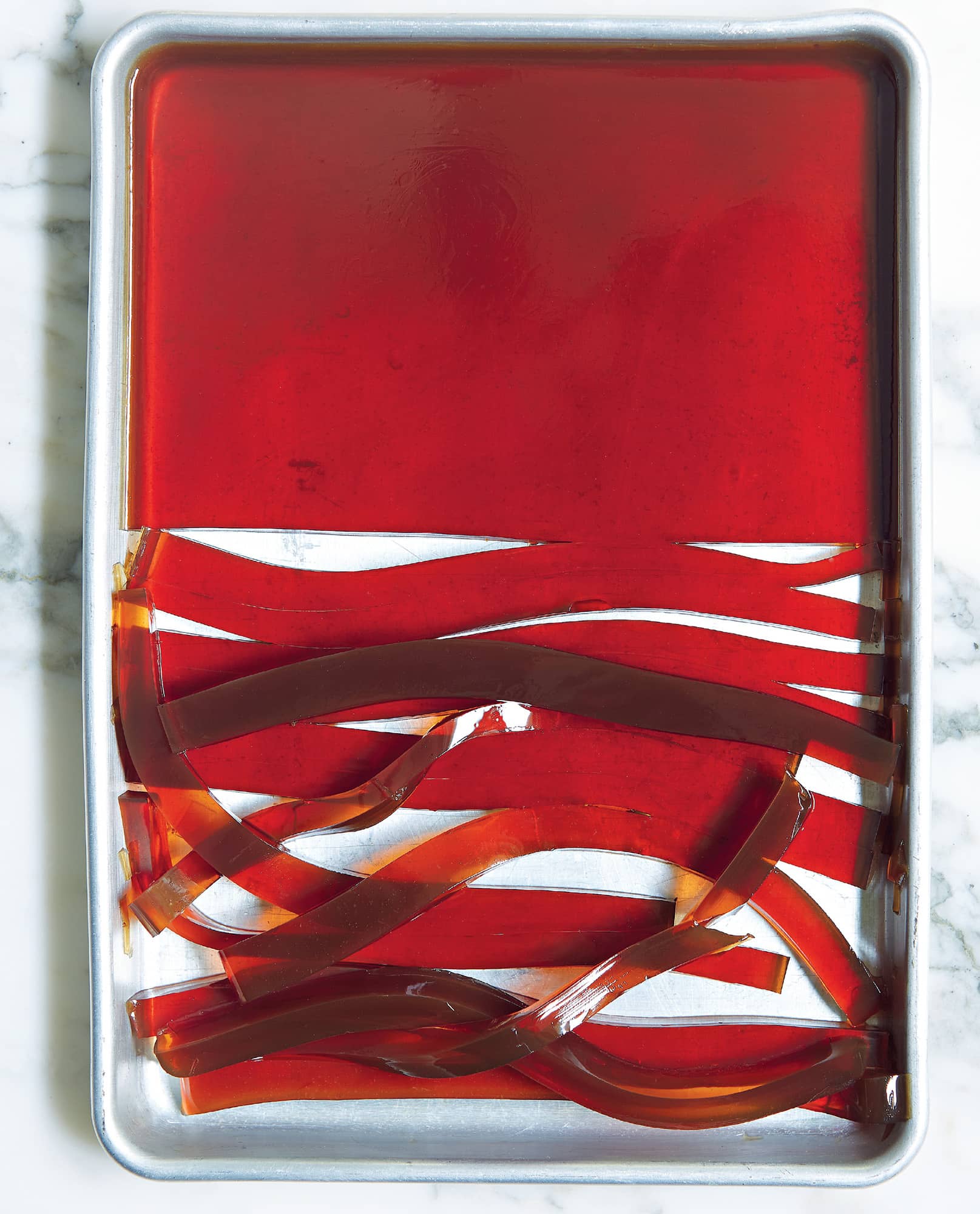
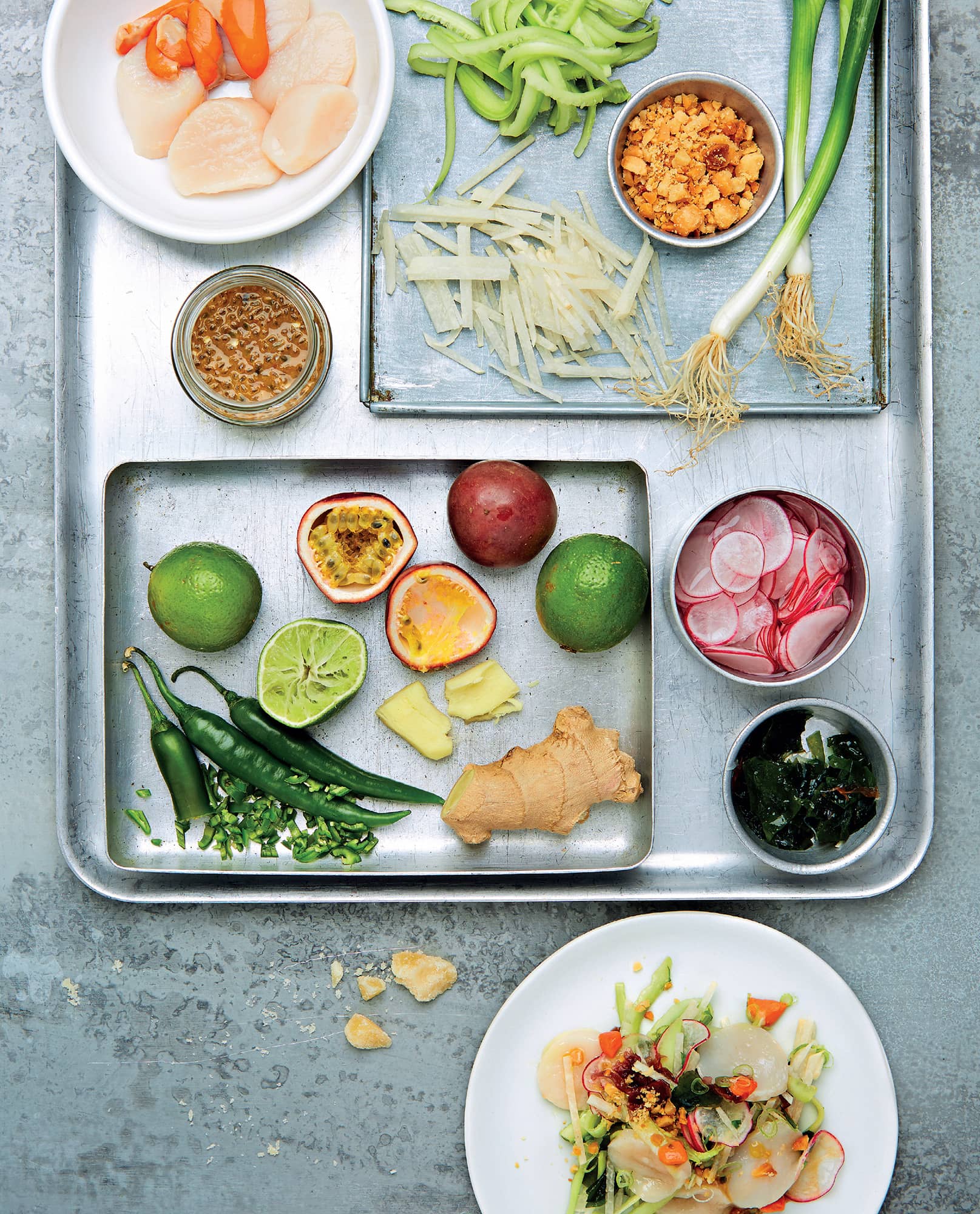
FOR 4 AS A STARTER
◁ Raw scallops, jicama, cucumber, radish, seaweed, passion fruit dressing and macadamia nuts
CHILLED
You need to use the best scallops you can buy for this dish. If you’re unable to source them then you can use the freshest raw fish, cooked prawns (shrimp) or even thinly sliced smoked salmon instead. The scallop coral (roe) adds a surprisingly delicious flavour element so don’t discard them. Jicama is also known as yam-bean and should be available in Southeast Asian supermarkets. If you have trouble finding it, you can substitute it with kohlrabi or nashi pear. Dried seaweed is now fairly easy to source and there are myriad types, from sea spaghetti and sea salad through to varieties such as arame, dulce and nori, to name but a few. They’re all quite different and will add colour, texture and innovation to your salad. If the seaweed you’re using is thick, steam it for 10 minutes after soaking, then refresh it under cold water and drain. I like eating passionfruit seeds as I enjoy their crunch and colour, but you may prefer to strain them out.
INGREDIENTS
300g (10 1/2oz.) scallops, cleaned, coral (roe) removed and saved
2 tsp extra virgin olive oil
5g dried seaweed
1/4 jicama (about 100g/3 1/2oz.), peeled and julienned or shaved
2 small cucumbers (or use 1/2 a regular cucumber), peeled, deseeded and sliced lengthways
4 radishes, thinly sliced
1 spring onion (scallion), thinly sliced
50g (1 3/4oz./1/3 cup) macadamia nuts, lightly toasted and roughly chopped
FOR THE PASSIONFRUIT DRESSING
4 tbsp fresh passionfruit pulp (3 or 4 passion fruit depending on how plump they are)
2 tbsp lime juice
1 tbsp soy sauce
1 tsp finely chopped or grated ginger
1/2 green chilli, finely chopped with seeds (more or less to taste)
2 tsp chopped or grated palm sugar (or light brown sugar)
2 tbsp sunflower oil
[ METHOD ]
Depending on how thick your scallops are, cut them horizontally into two or three slices. Place in a non-reactive dish and sprinkle with 1/4 teaspoon of salt and the olive oil. Cover and put in the fridge. Chop the coral (roe) into pieces and place in a small bowl in the fridge.
Soak the dried seaweed in boiling water for 30 minutes, then drain.
Make the passionfruit dressing. Place the passionfruit pulp, lime juice, soy sauce, ginger, chilli and palm sugar in a jar and shake vigorously until the sugar has dissolved. Add the sunflower oil and shake again.
Mix a third of the dressing into the coral (roe). Put back in the fridge for 10 minutes.
To serve, toss the jicama, cucumber, radishes, spring onion (scallion) and seaweed together and divide among four chilled plates. Lay the scallop slices on, then spoon on the coral (roe). Spoon on the remaining dressing and sprinkle with the macadamia nuts.